
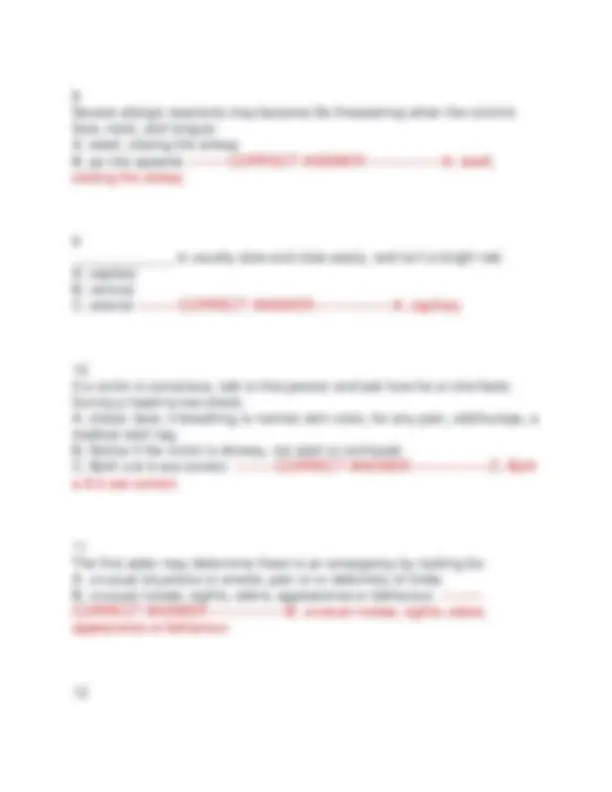
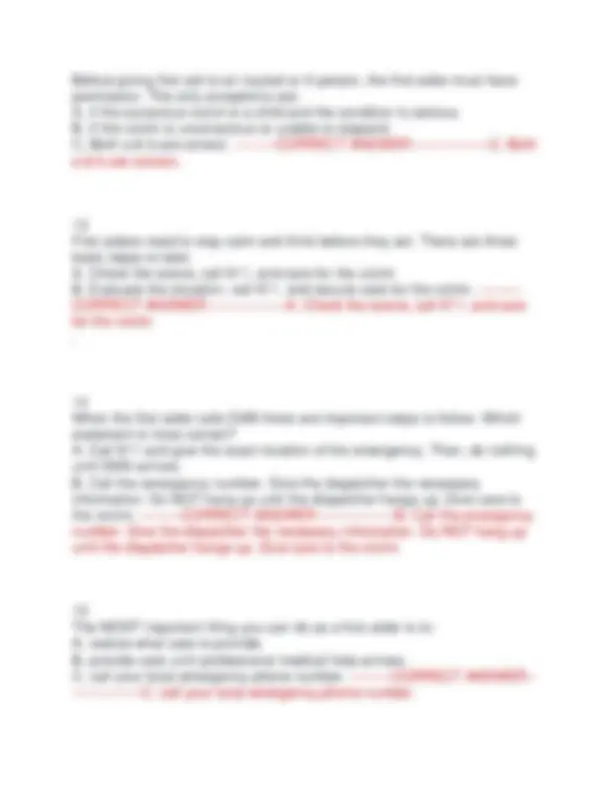
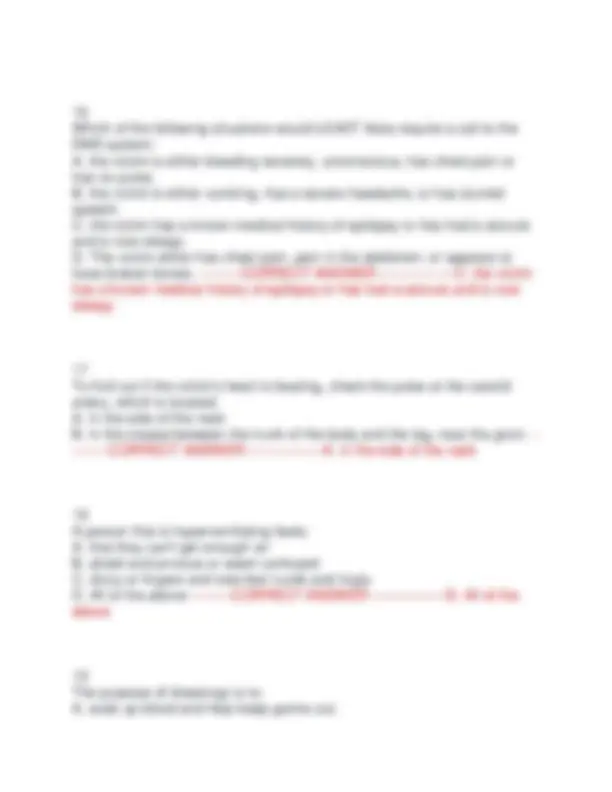
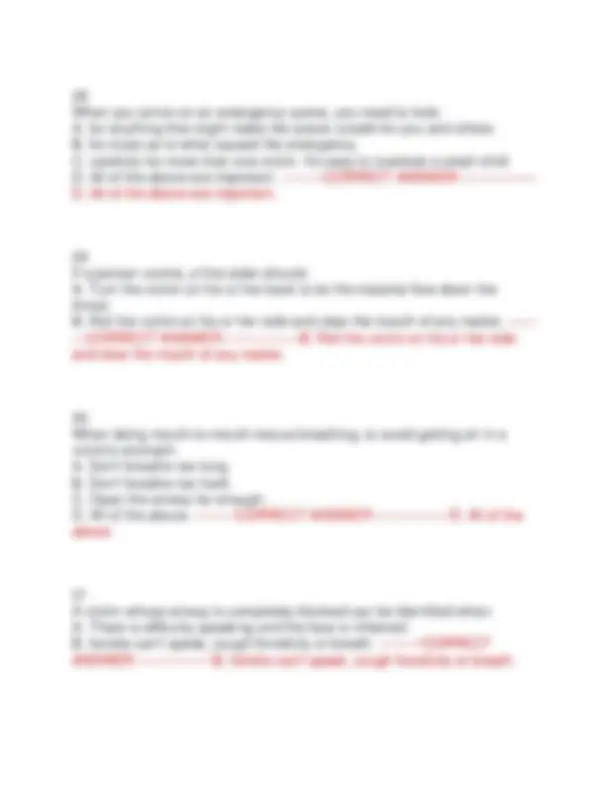
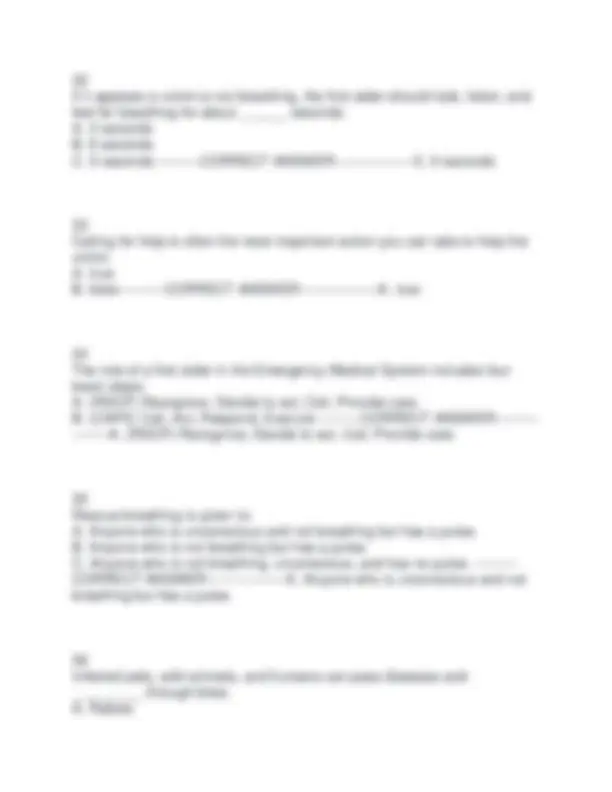
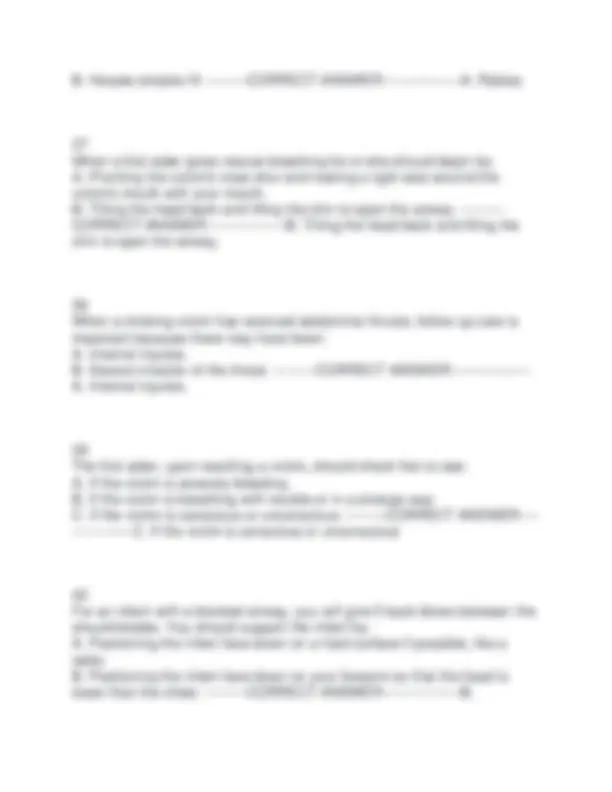
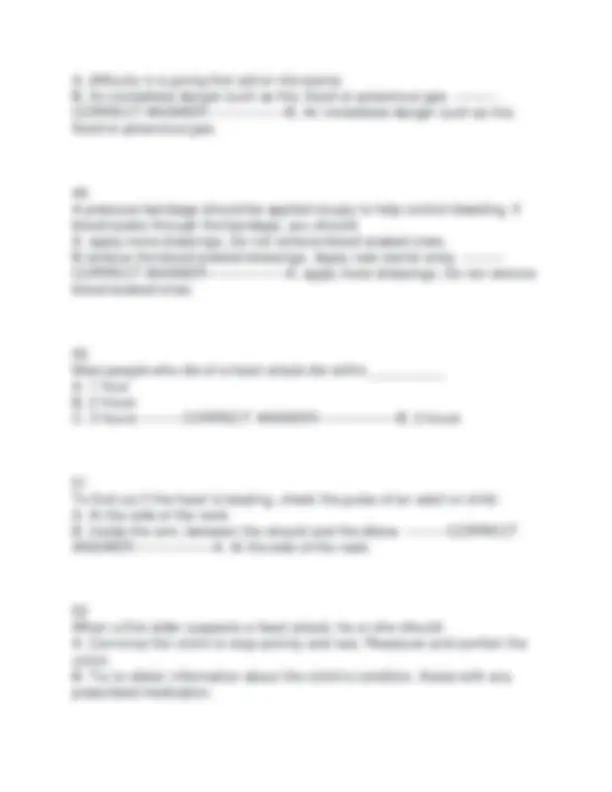
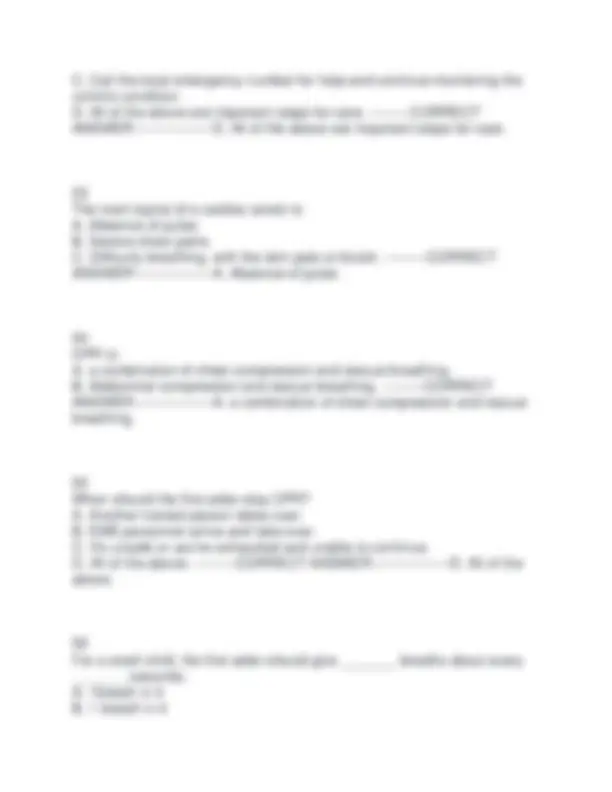
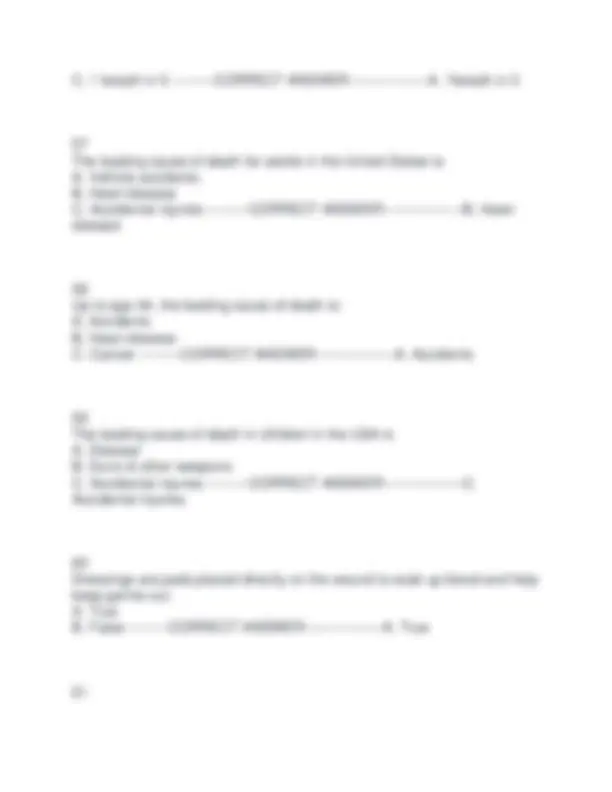
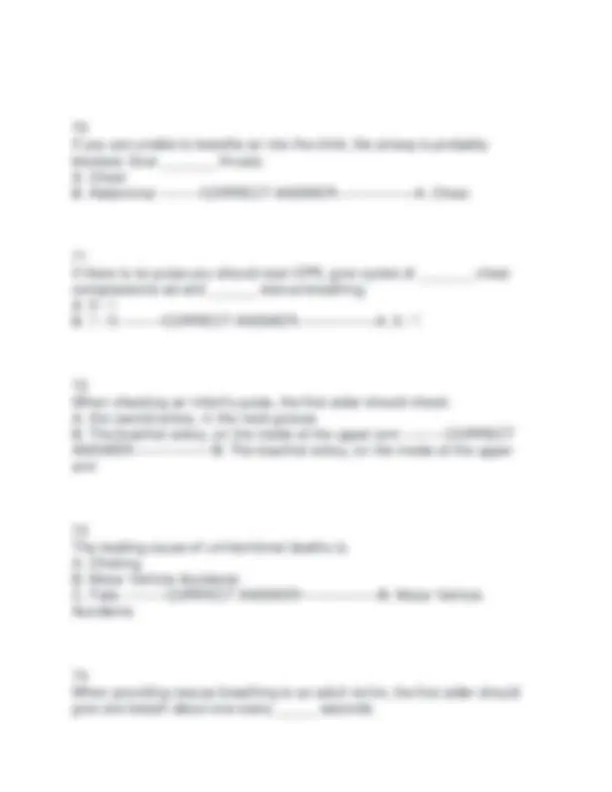
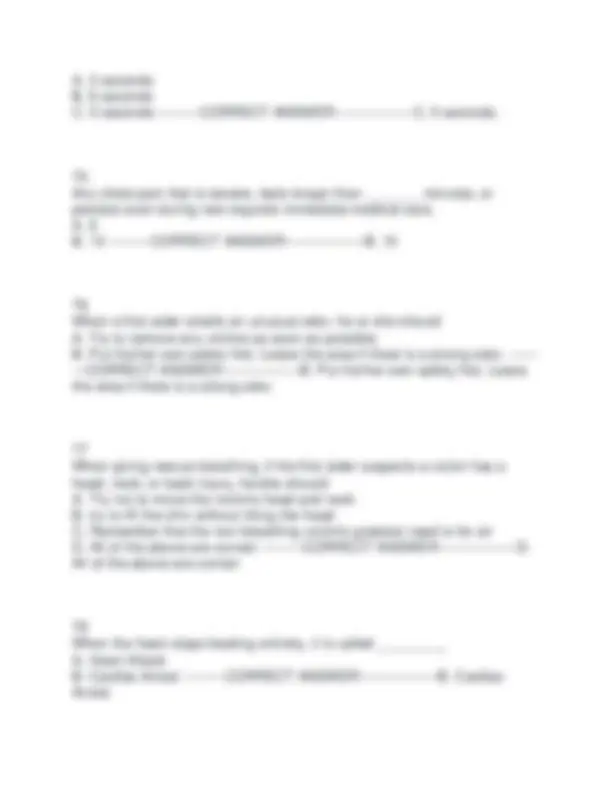
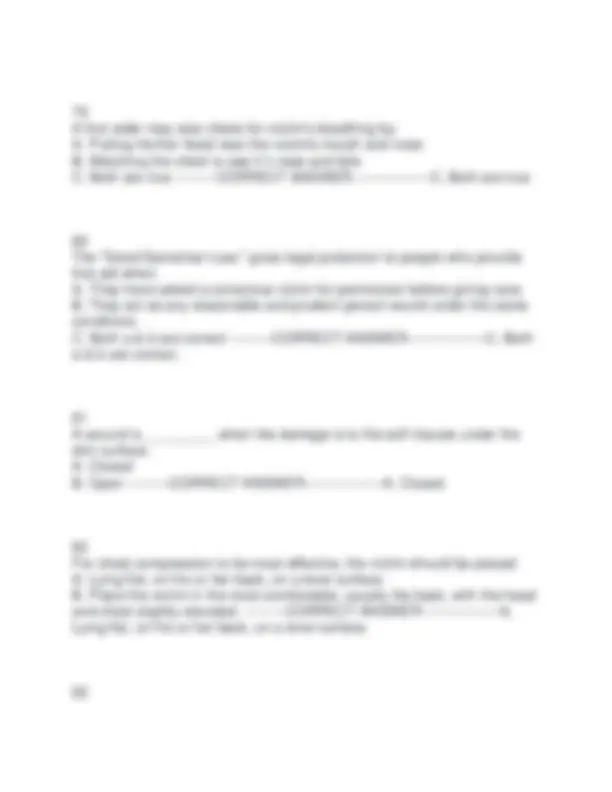
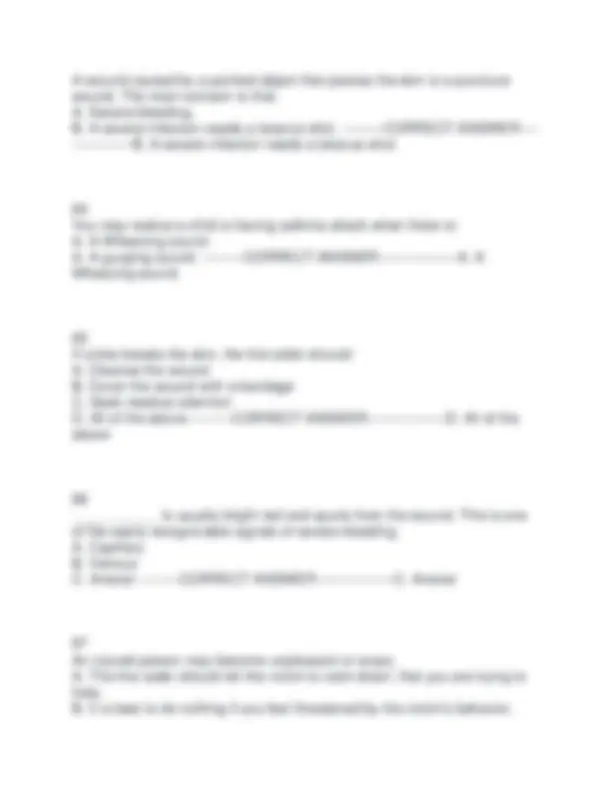
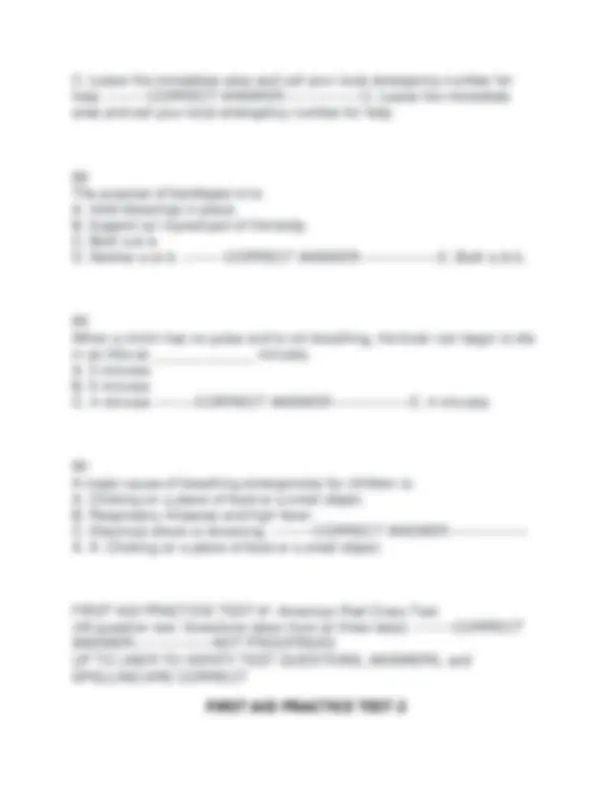
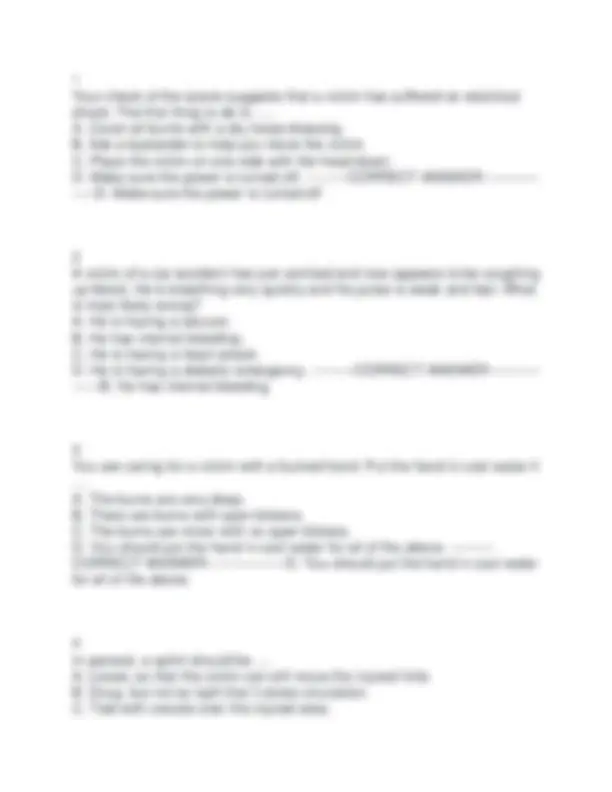
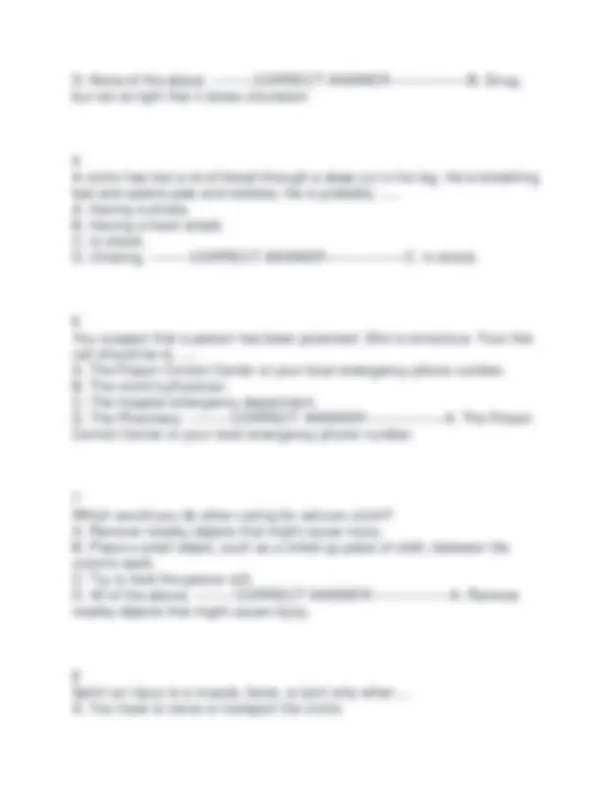
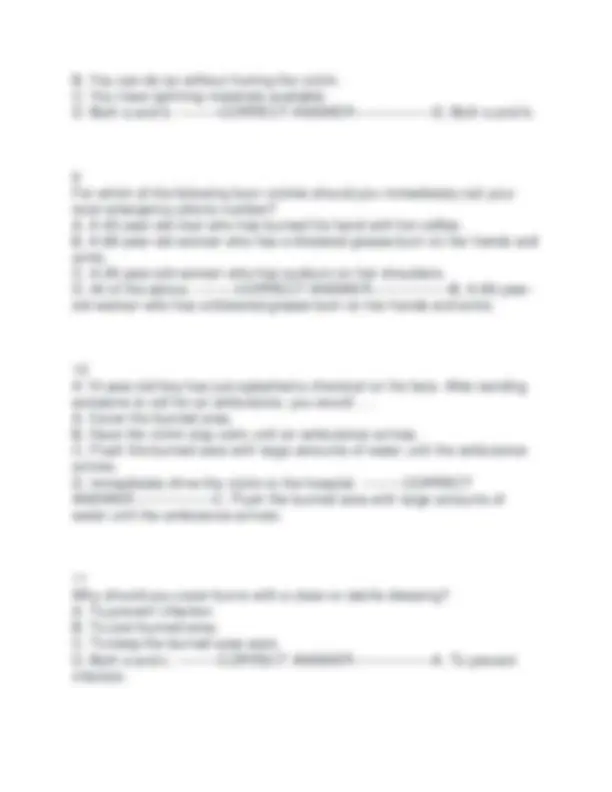
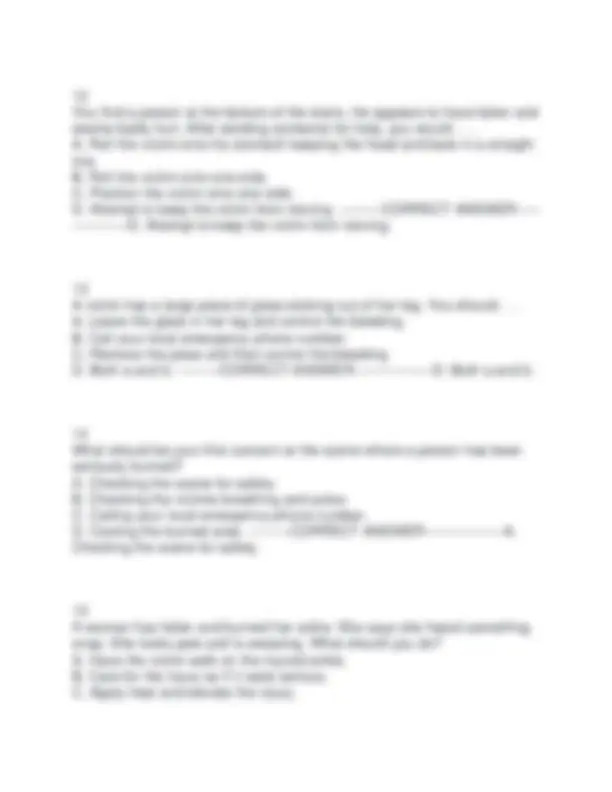
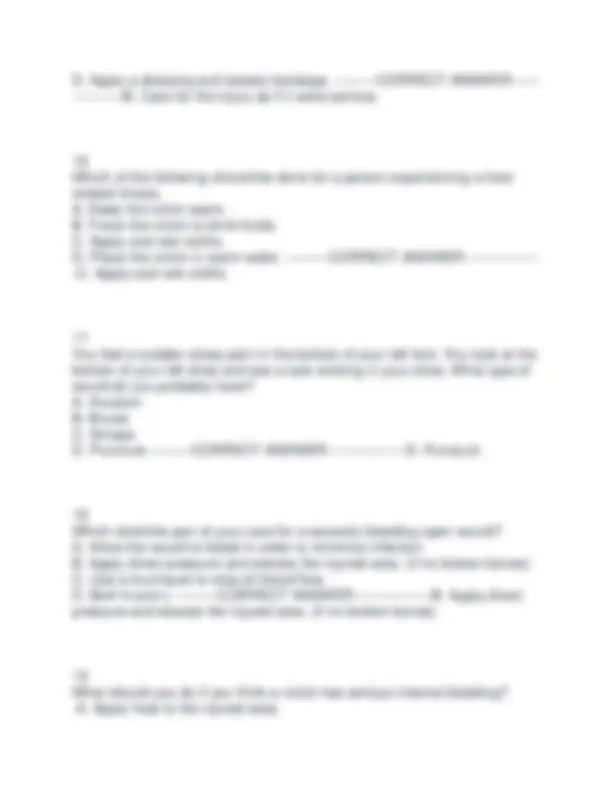
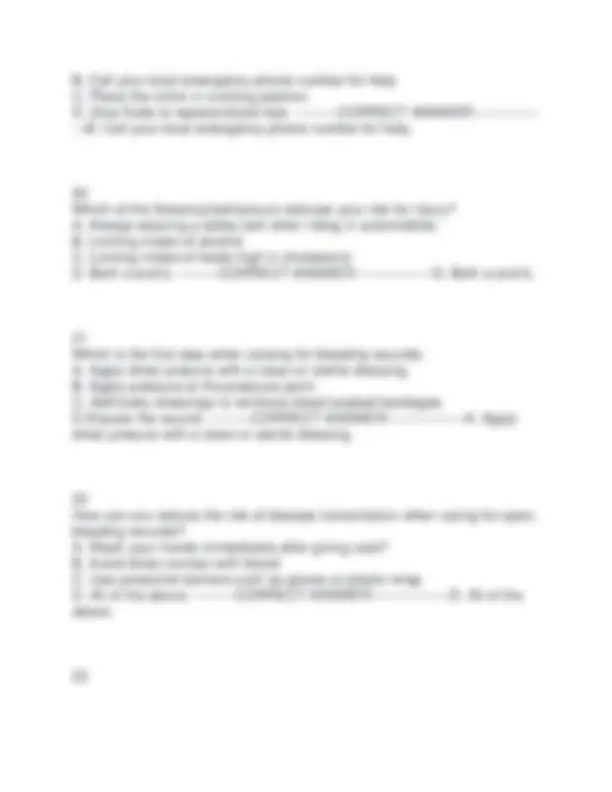
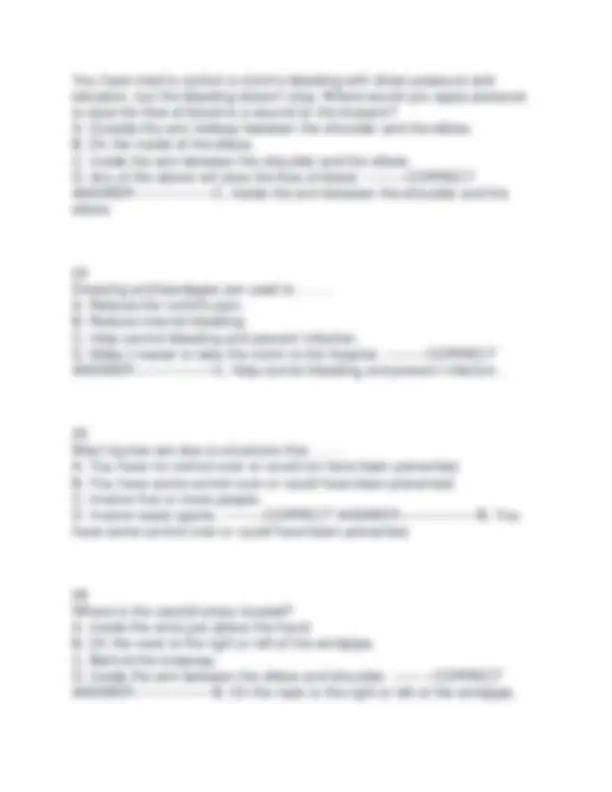
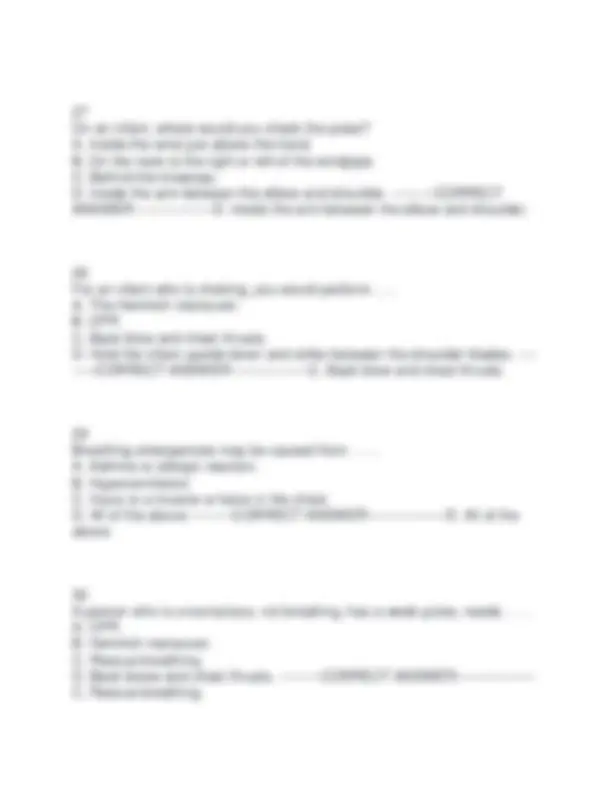
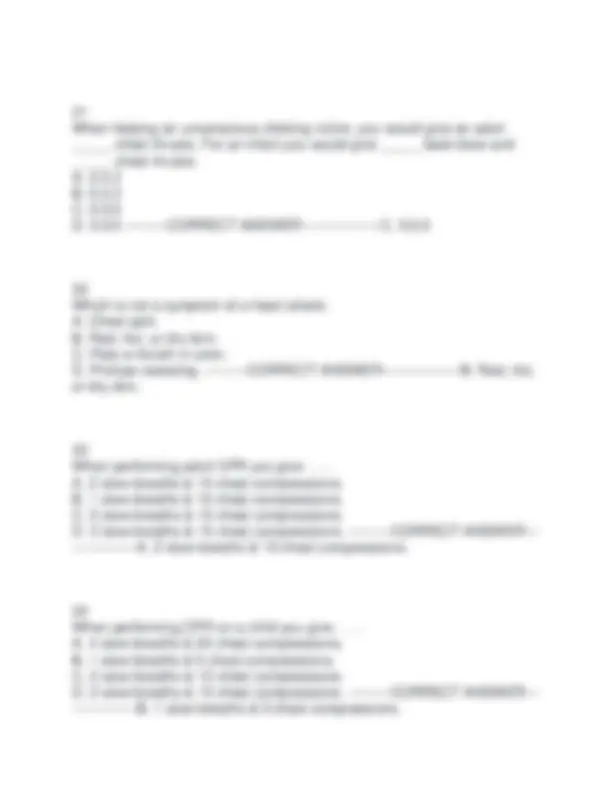
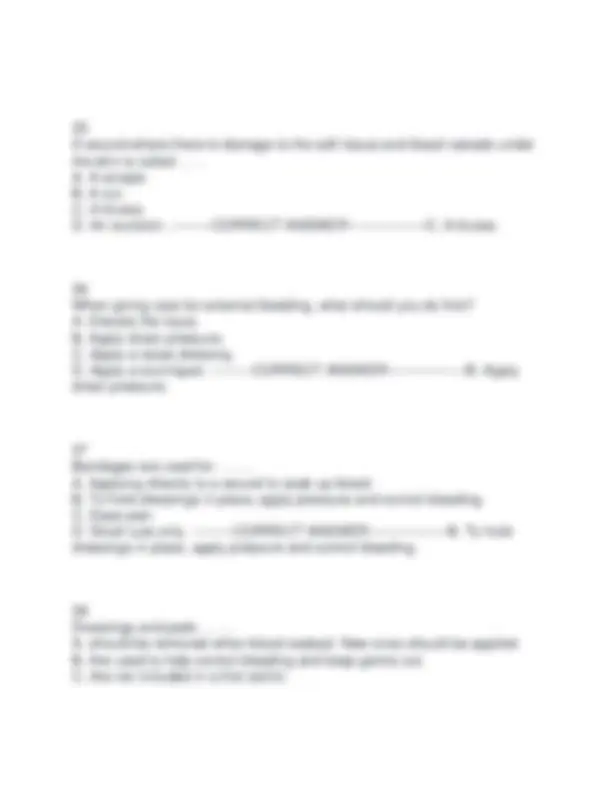
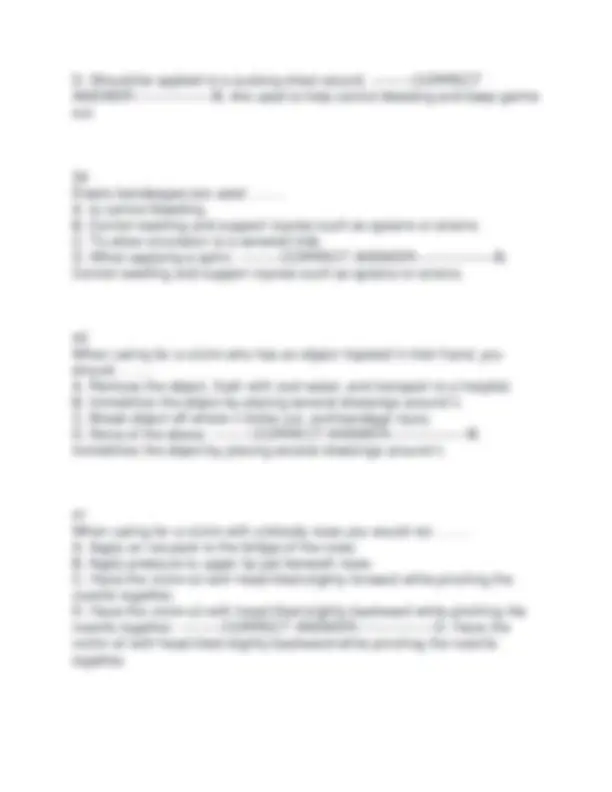
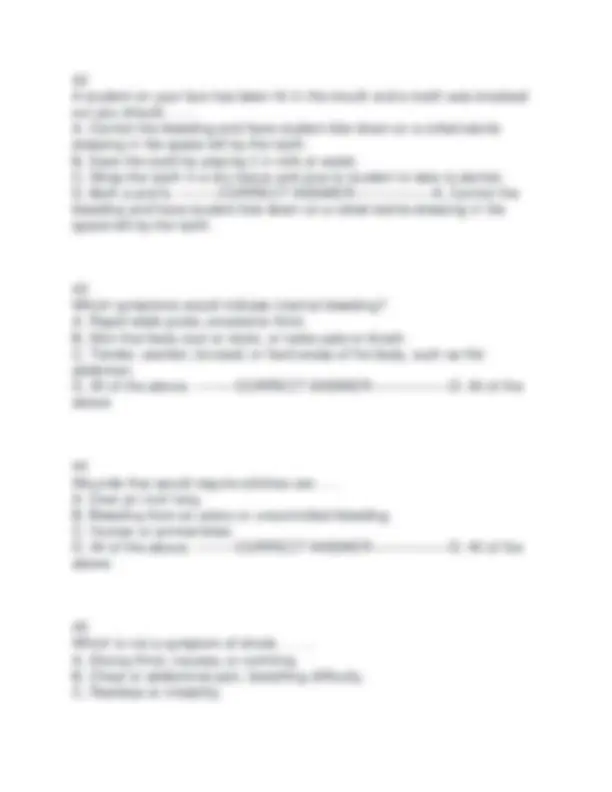
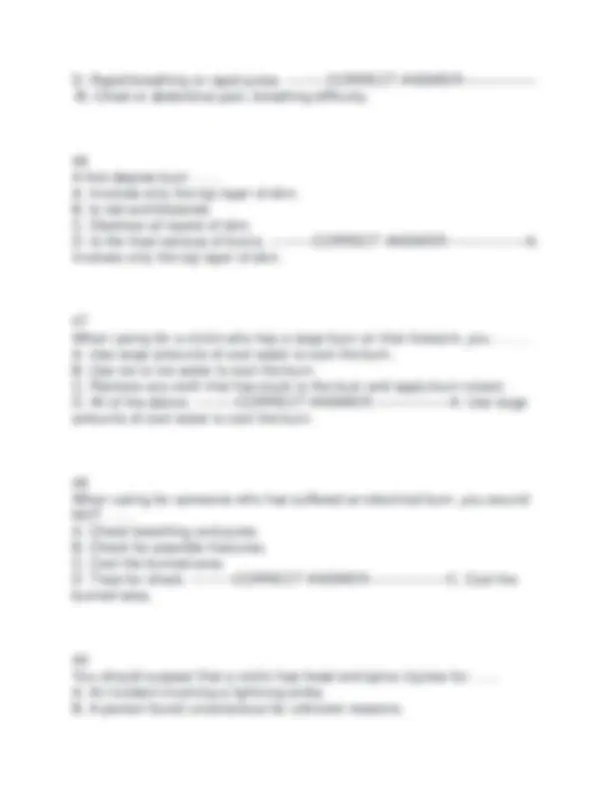
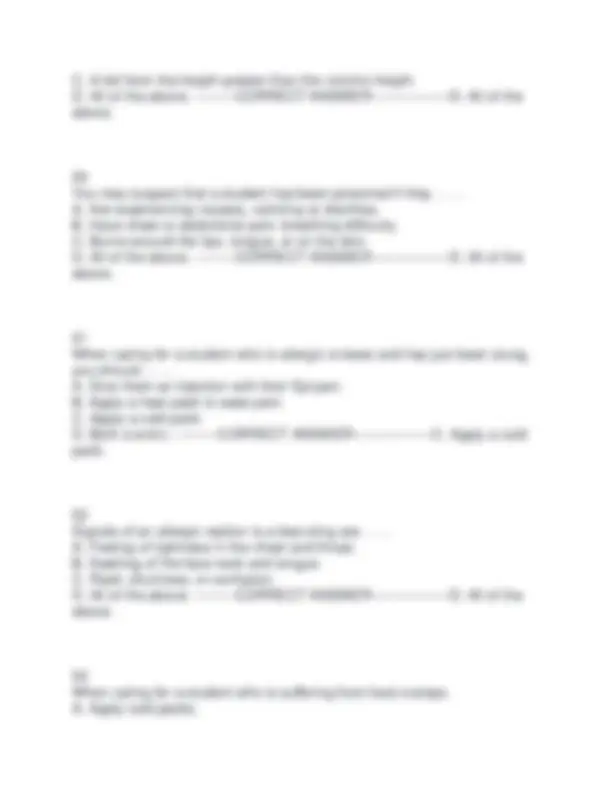
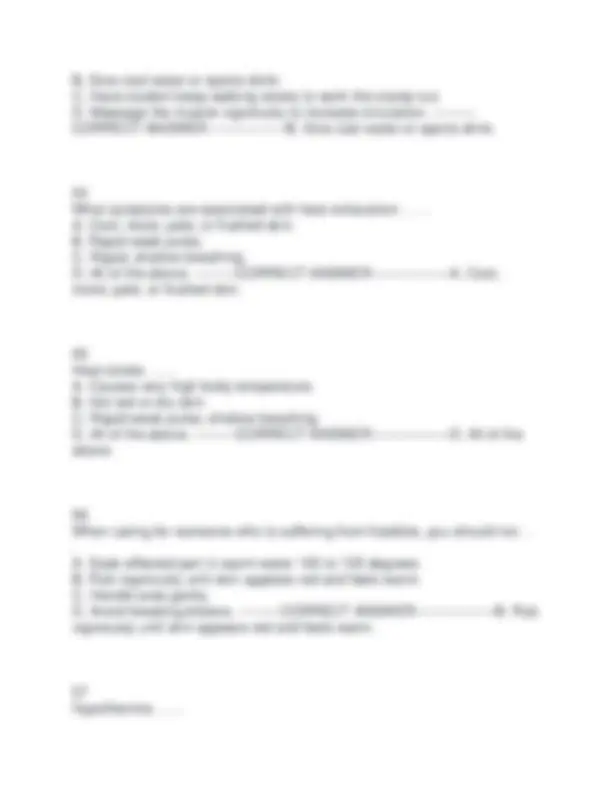
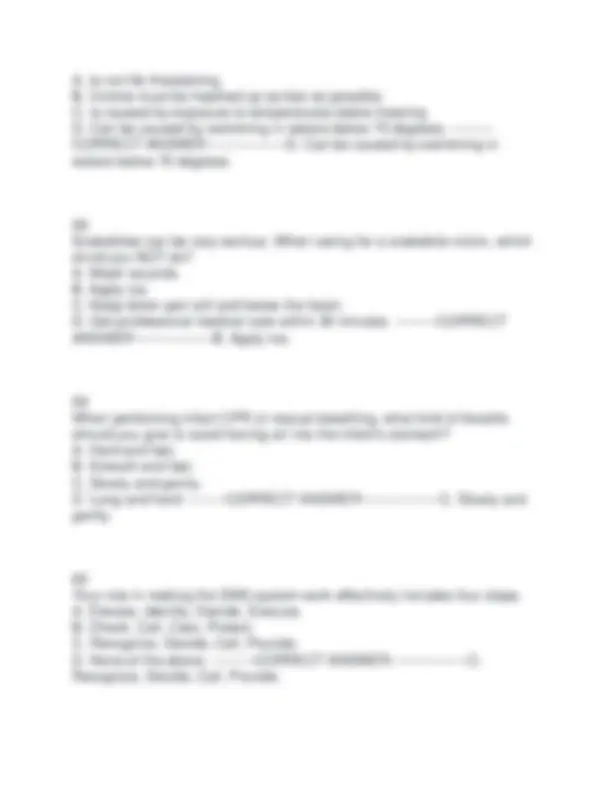
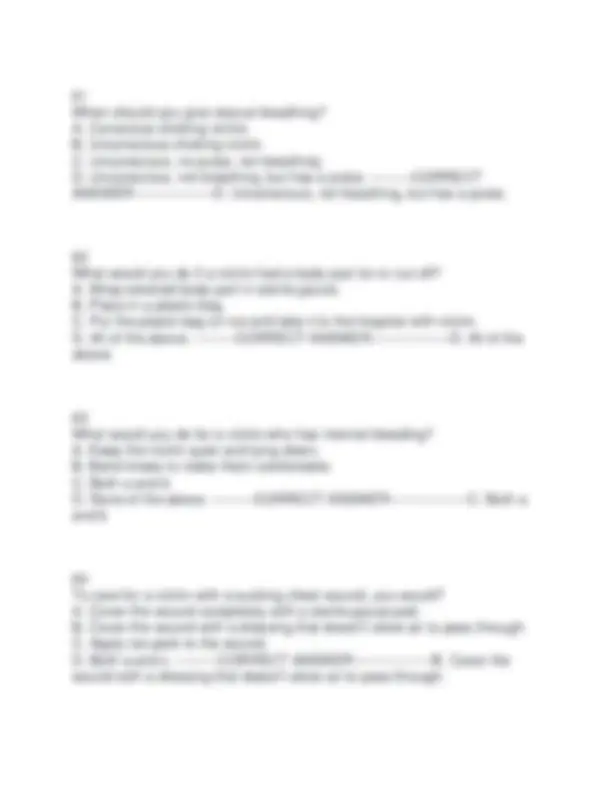
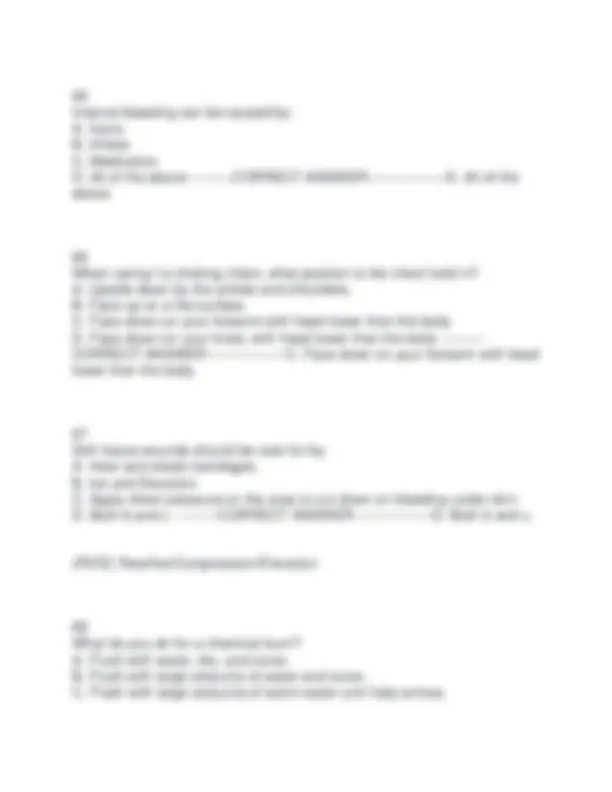
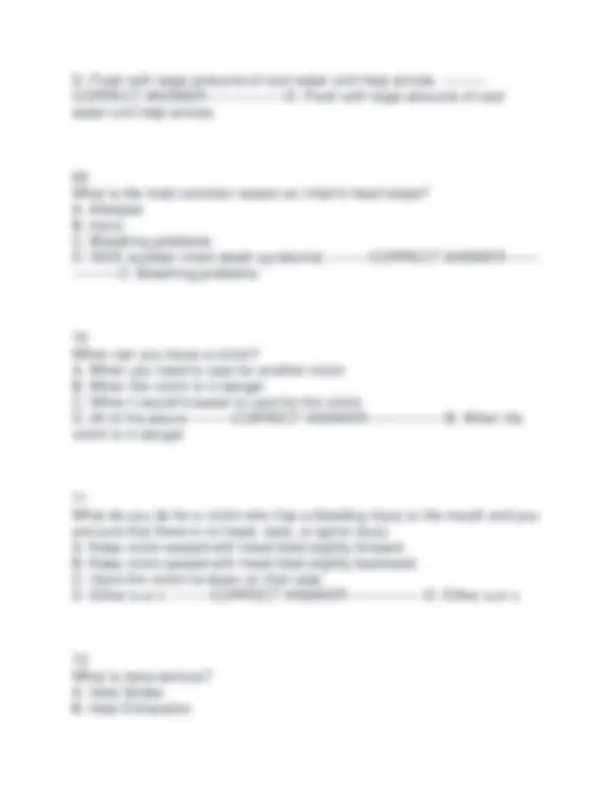
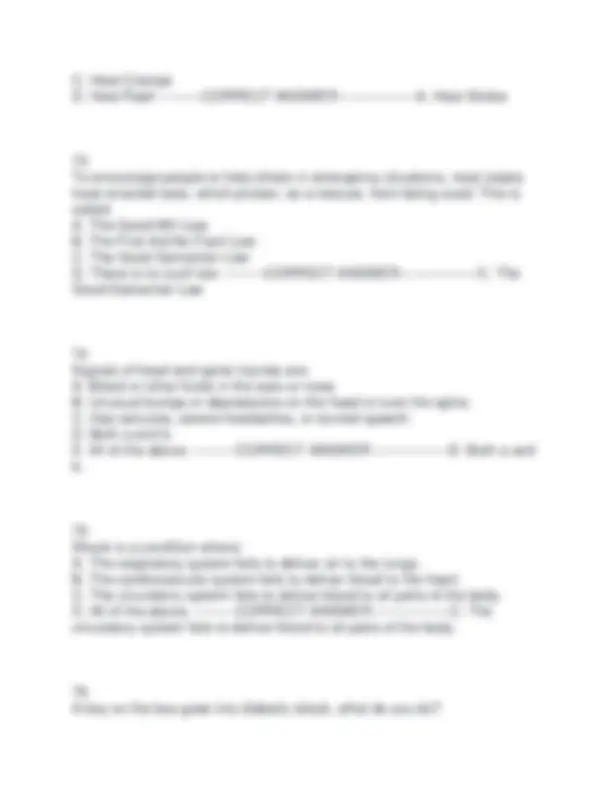
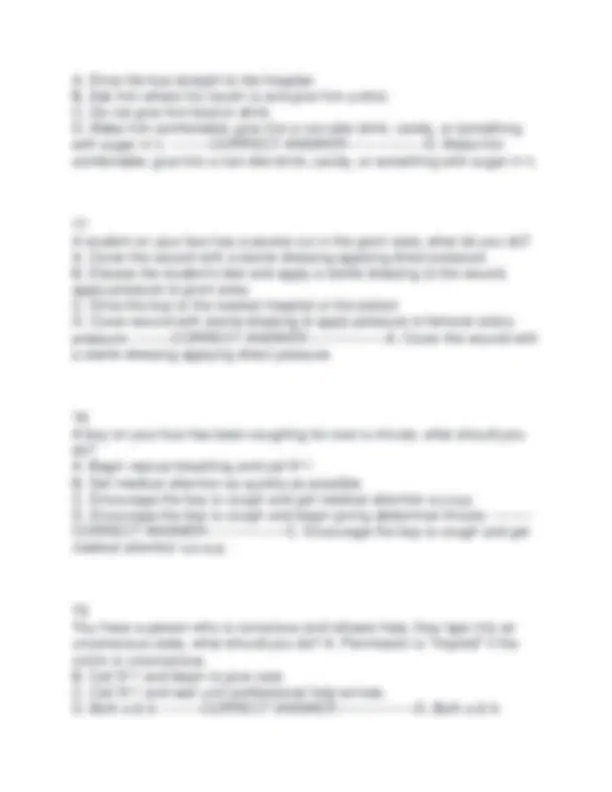
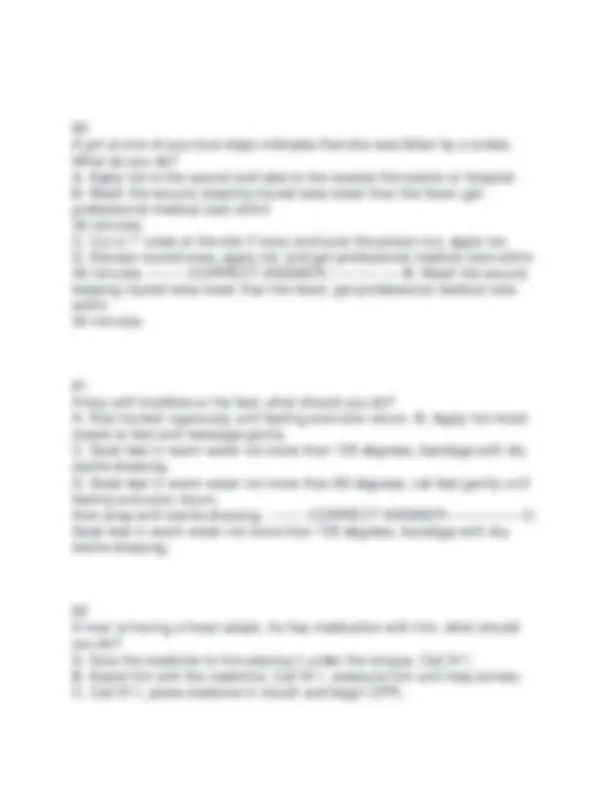
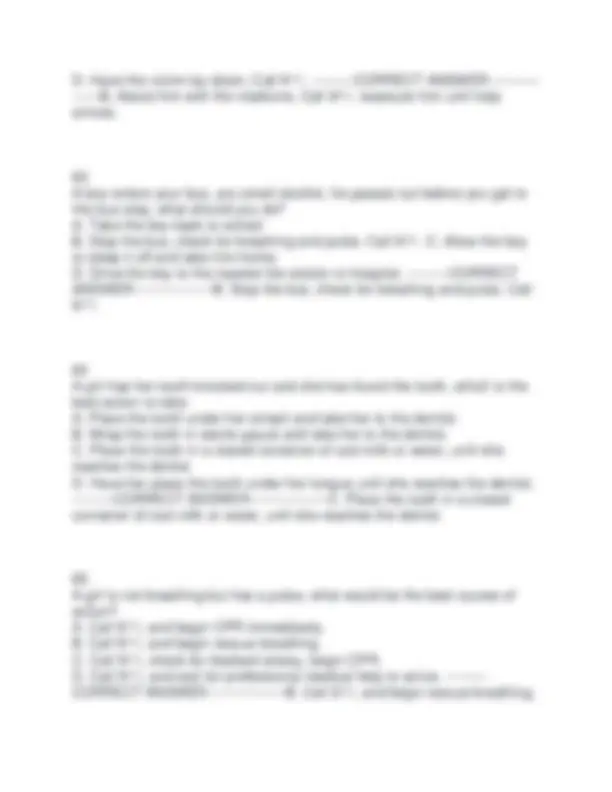
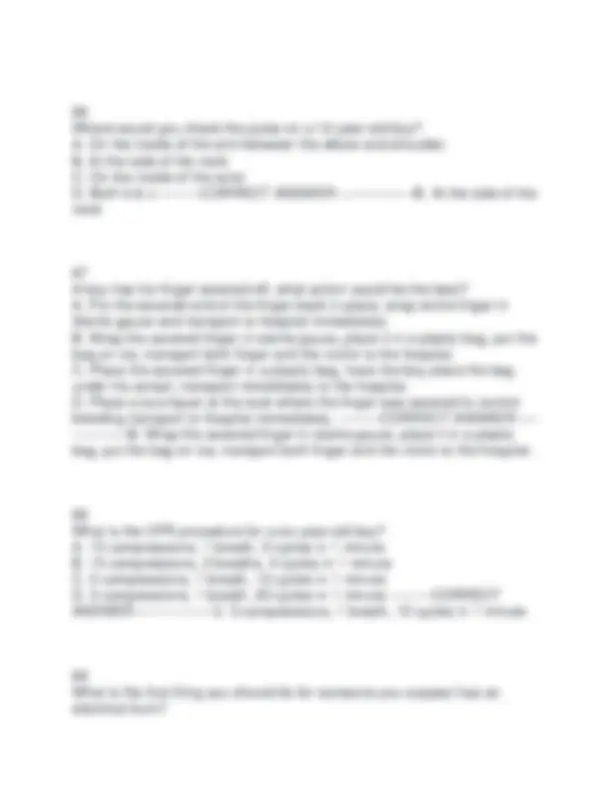
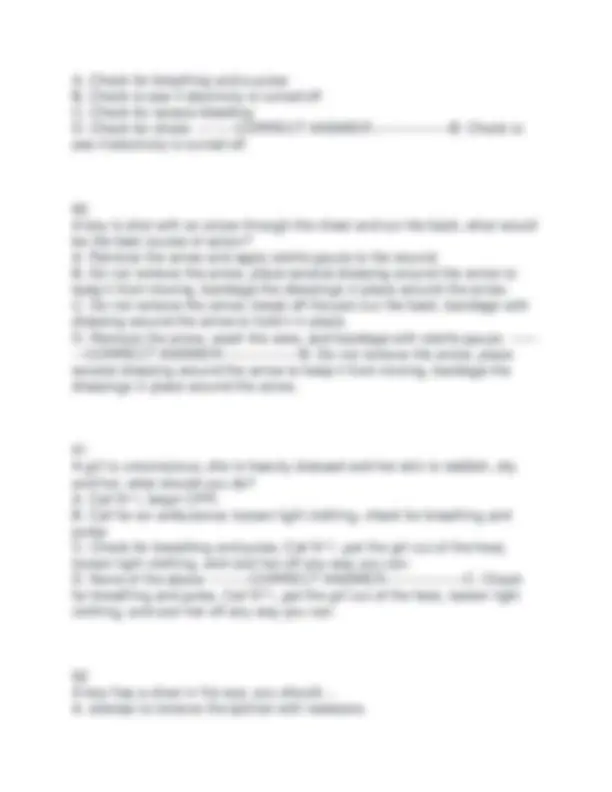
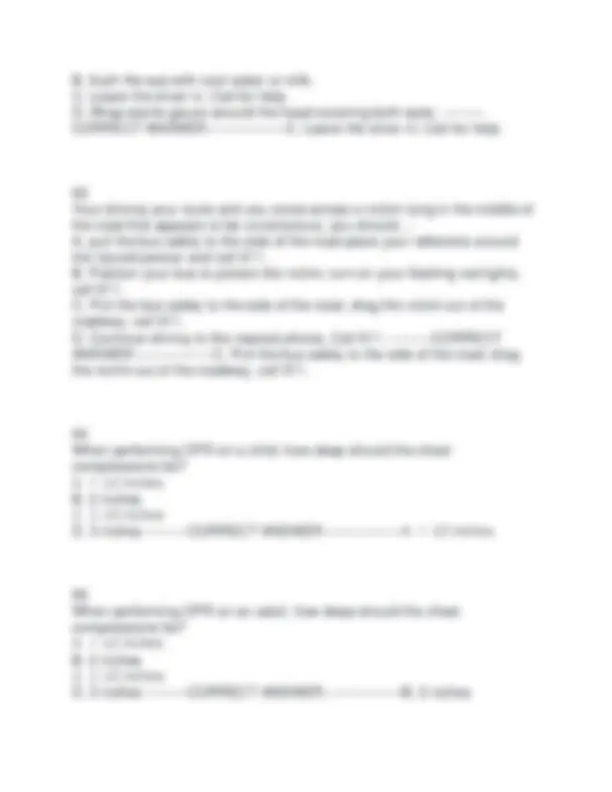
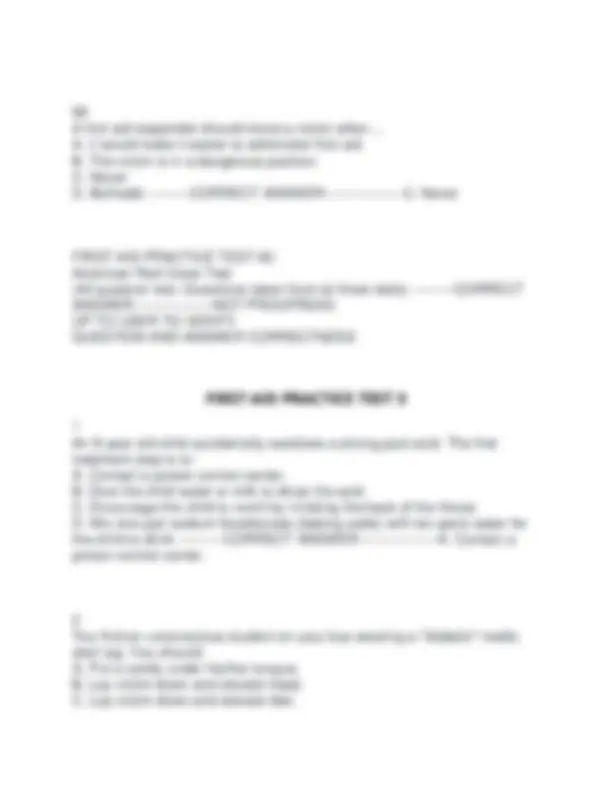
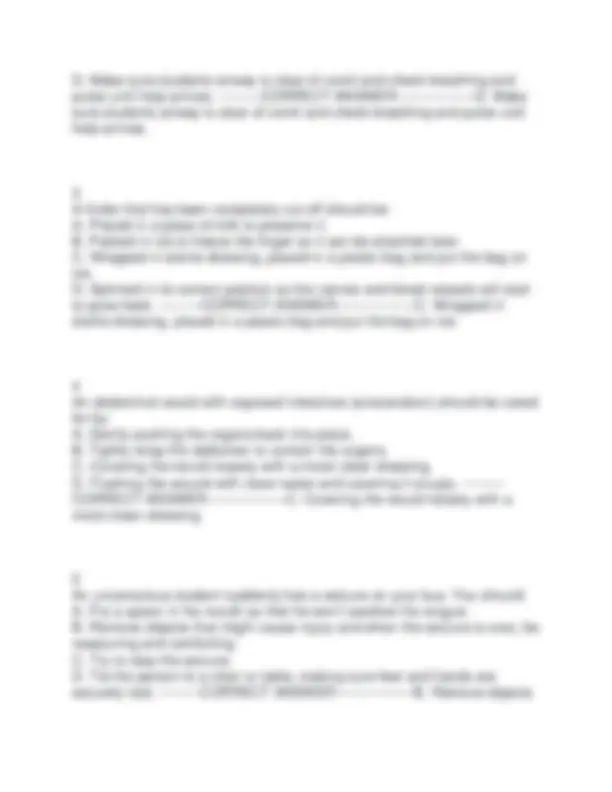
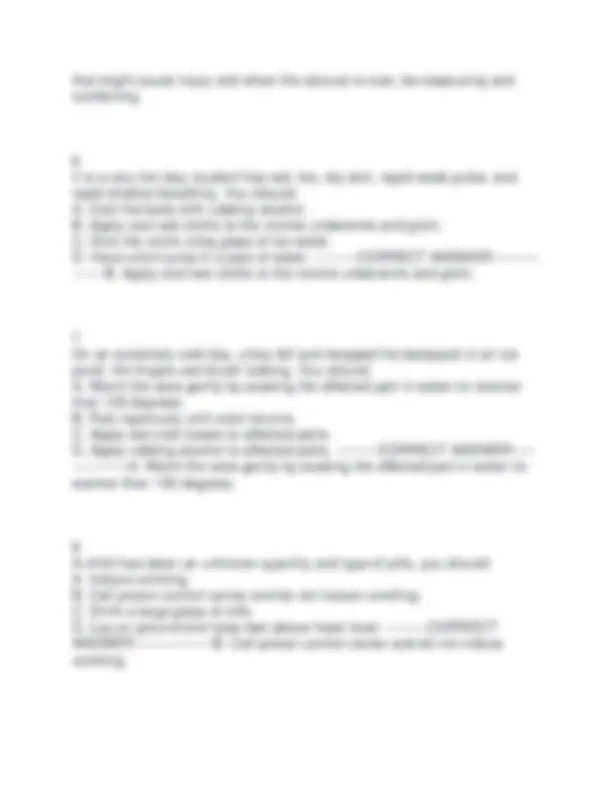
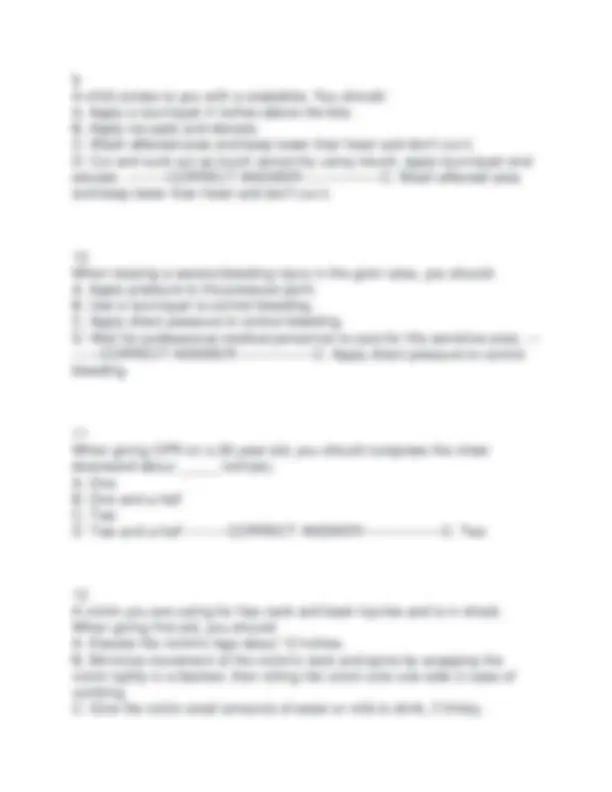
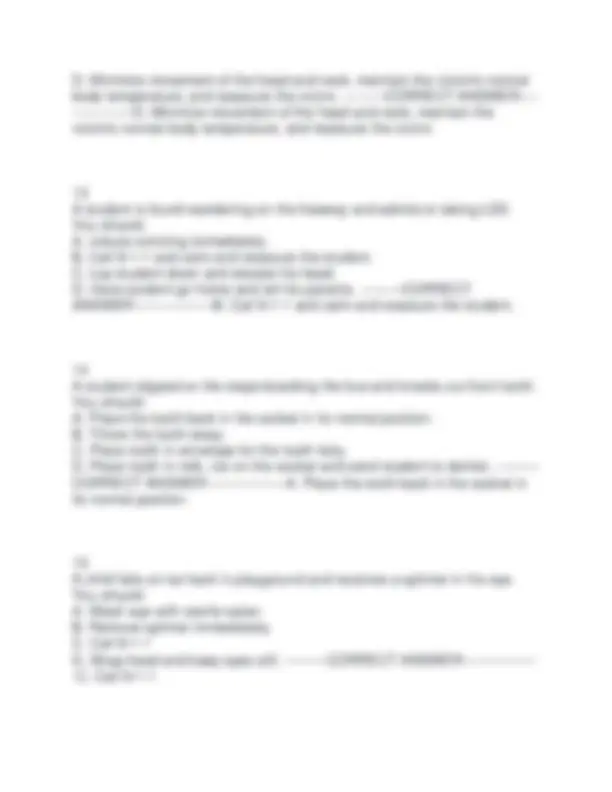
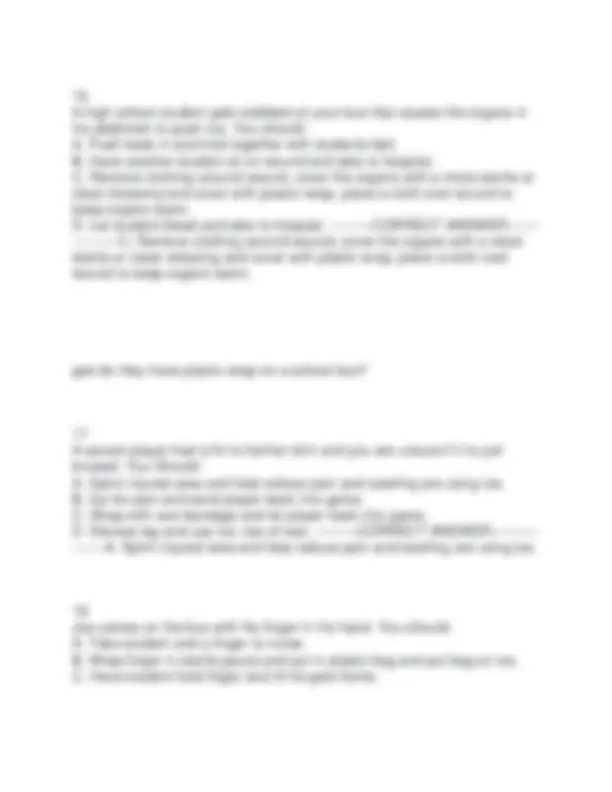
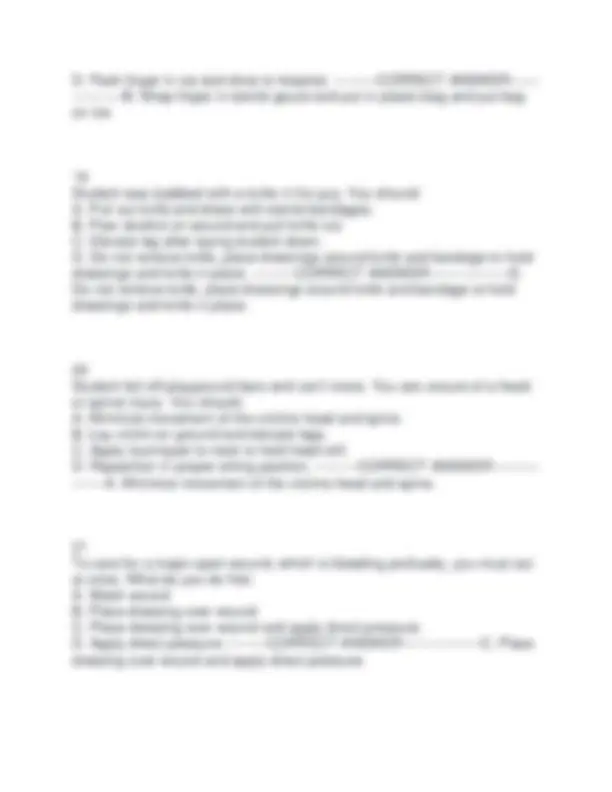
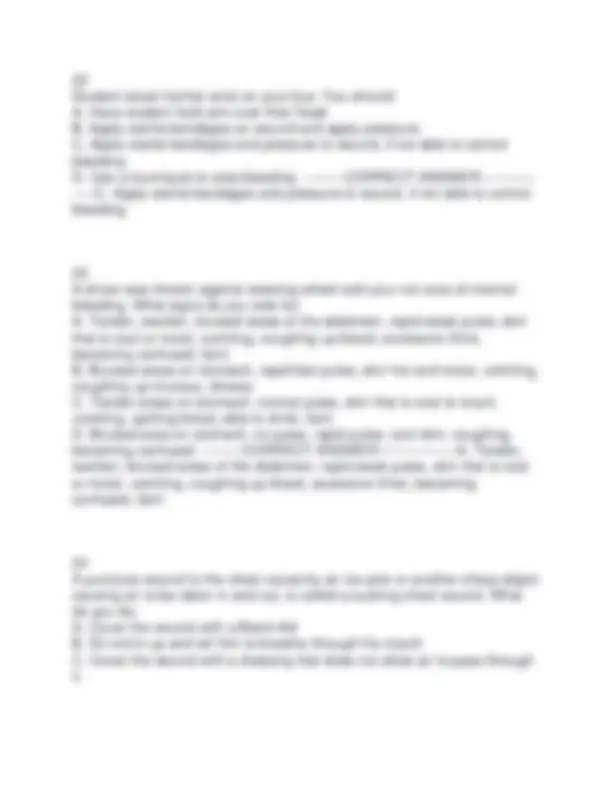
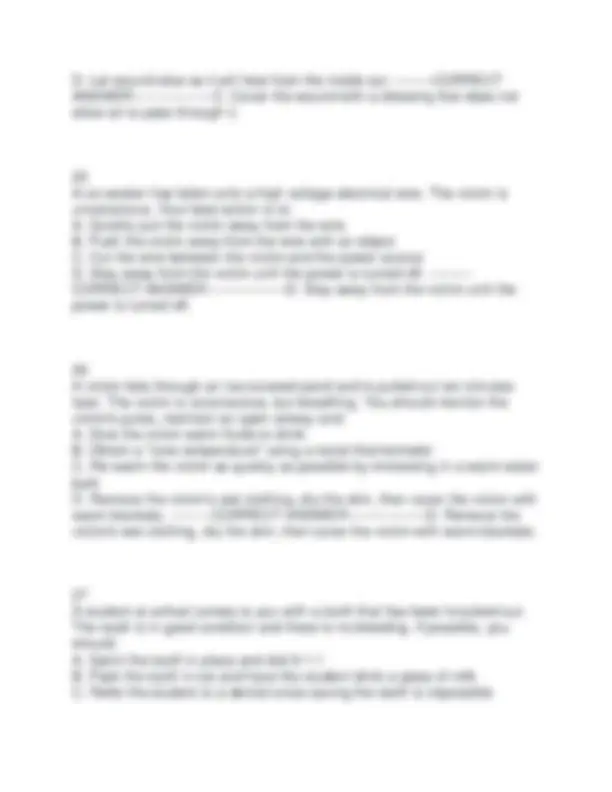
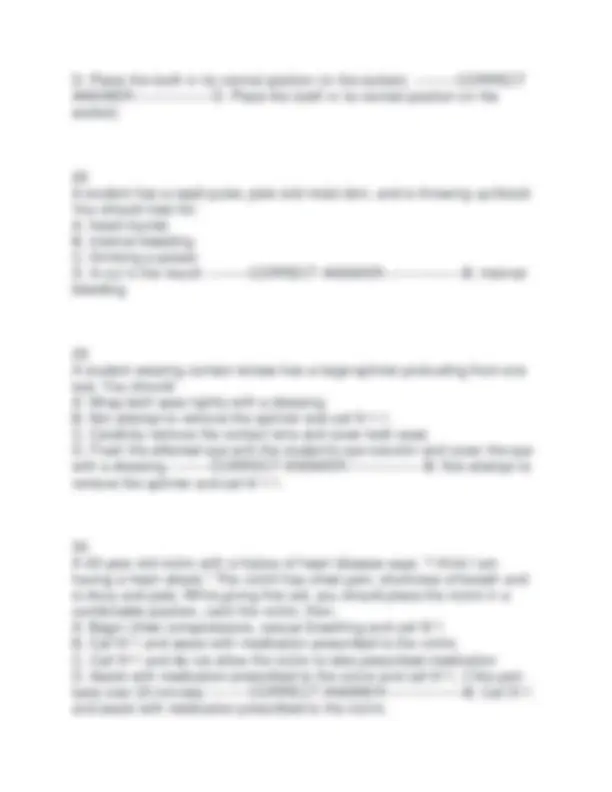

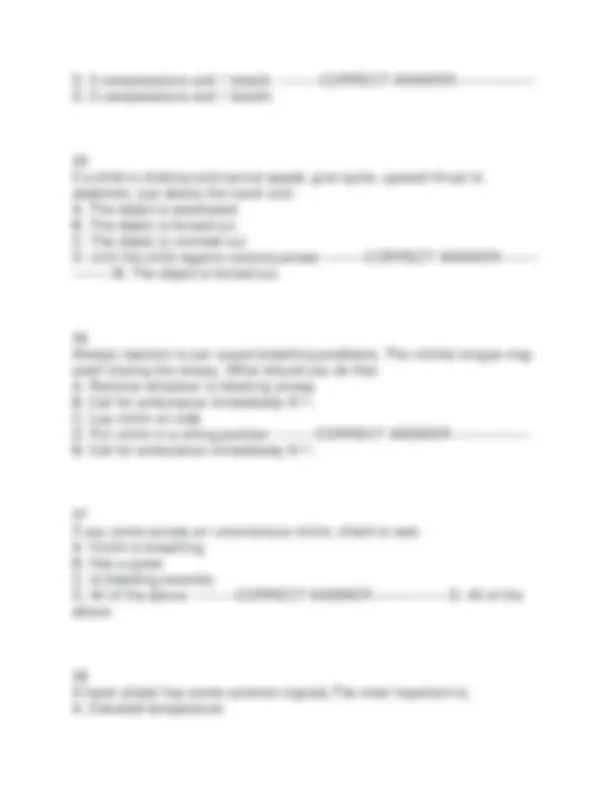
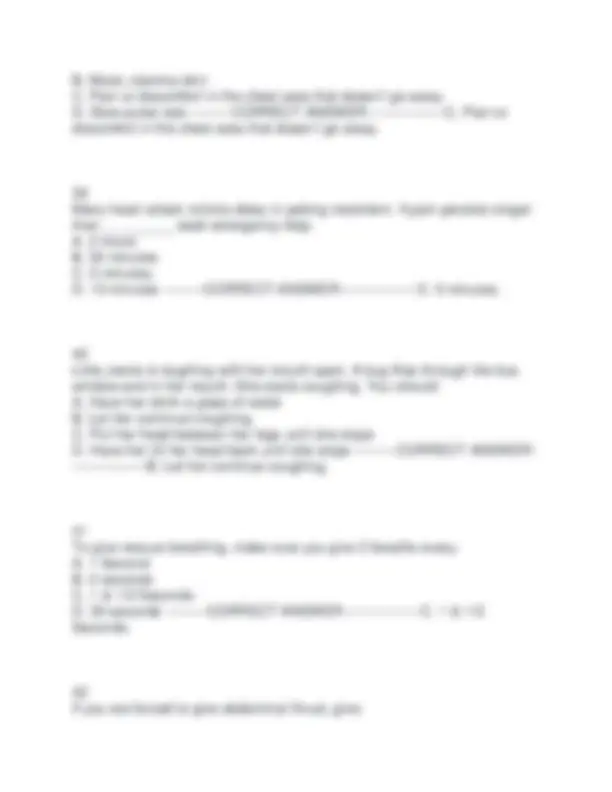
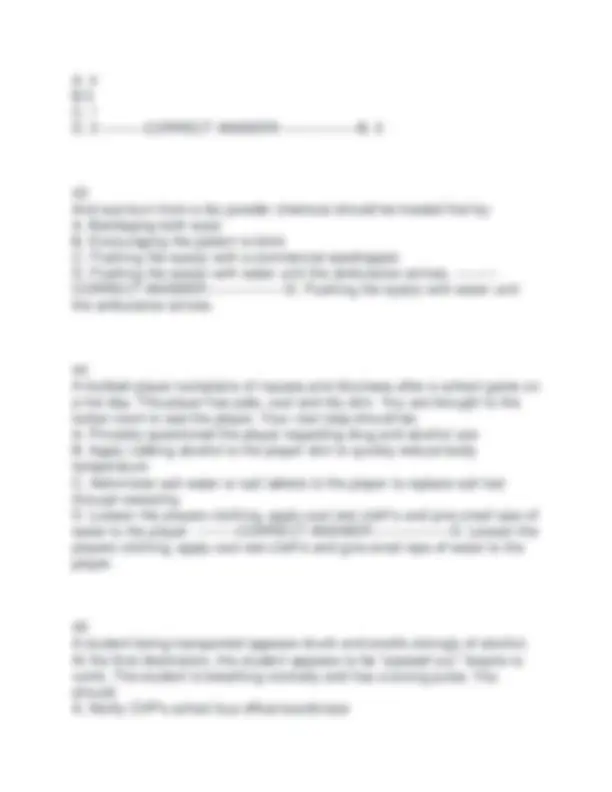
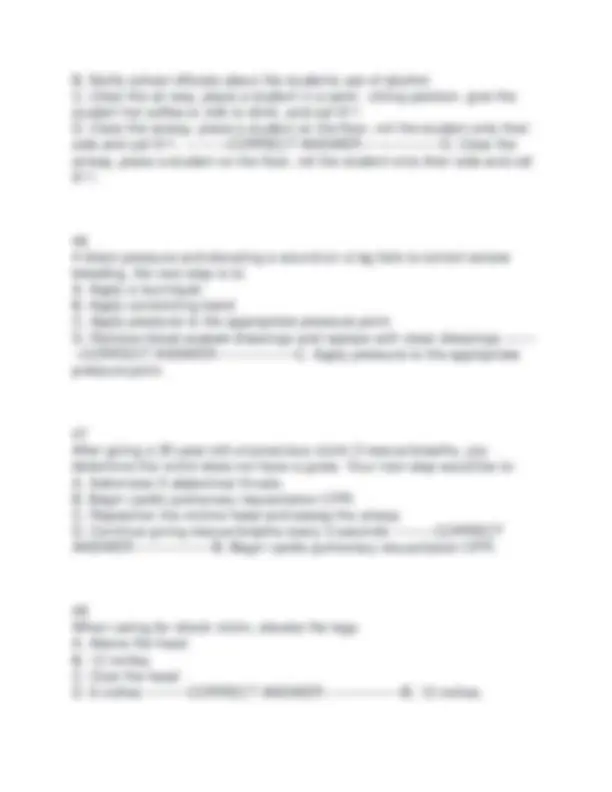
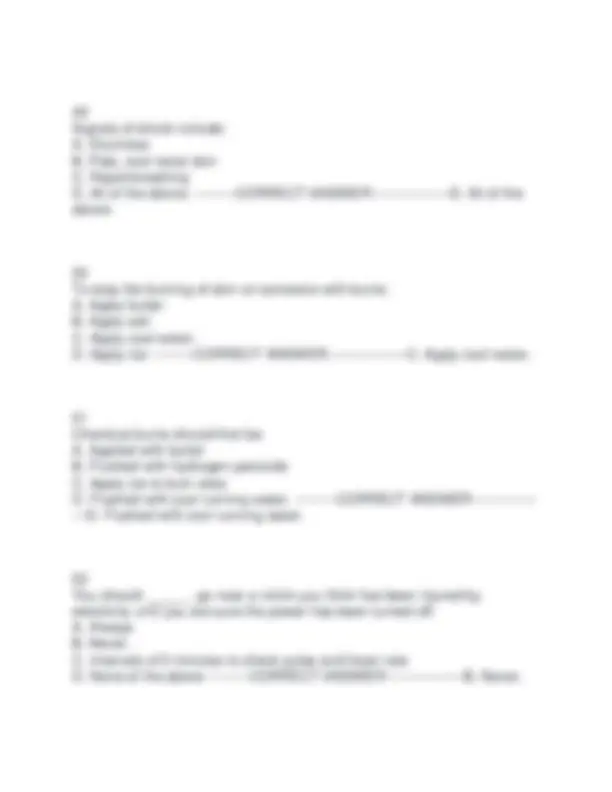
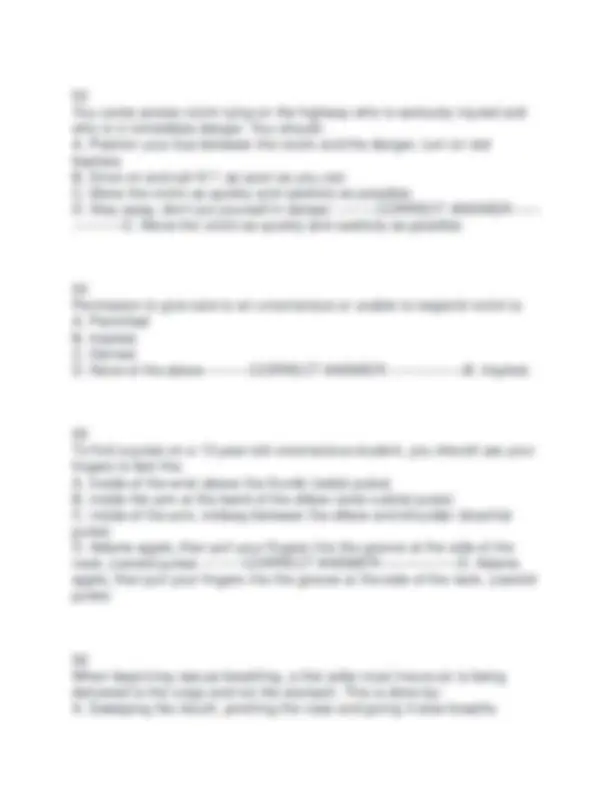
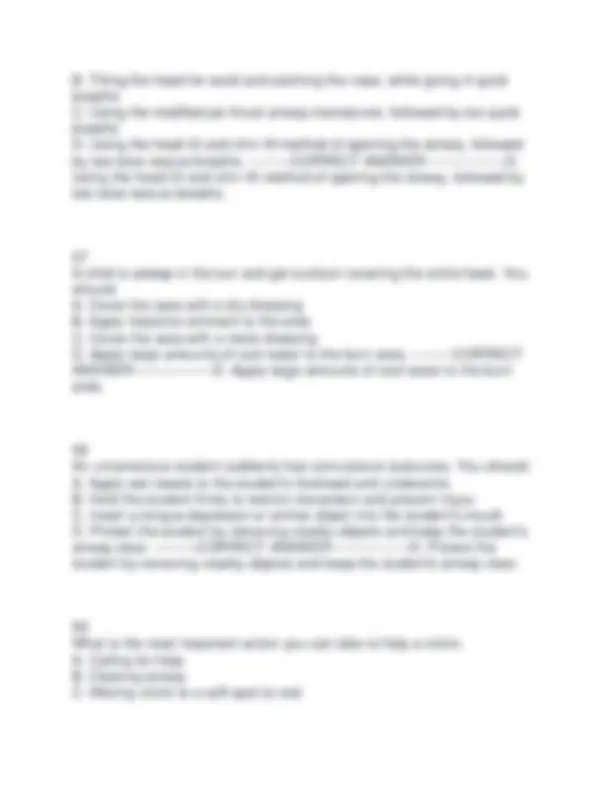
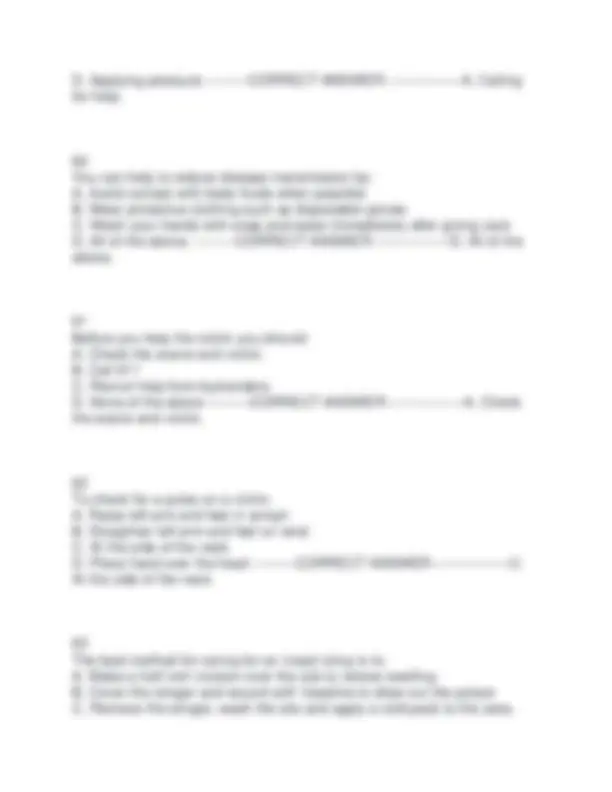
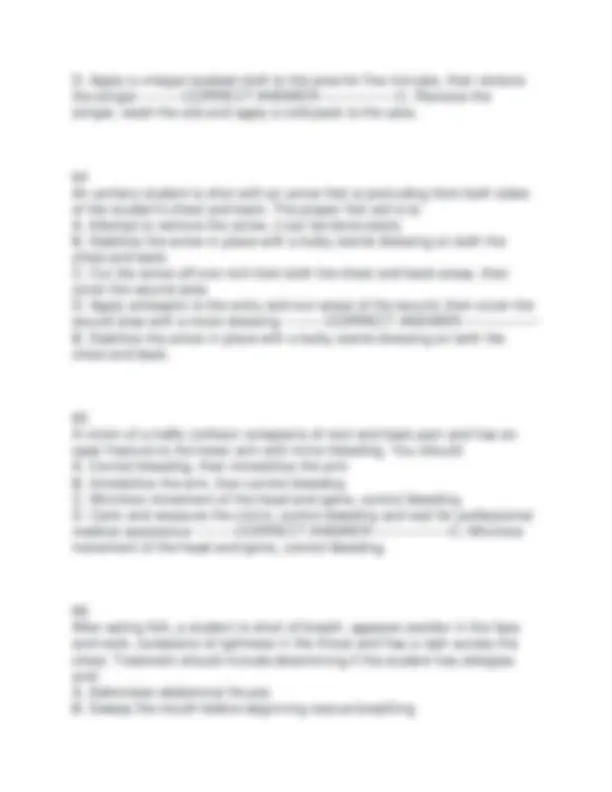
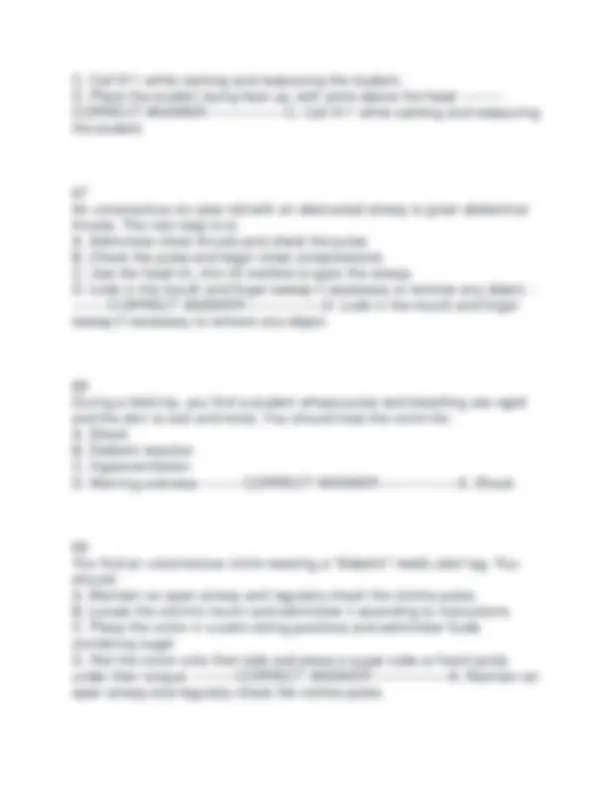
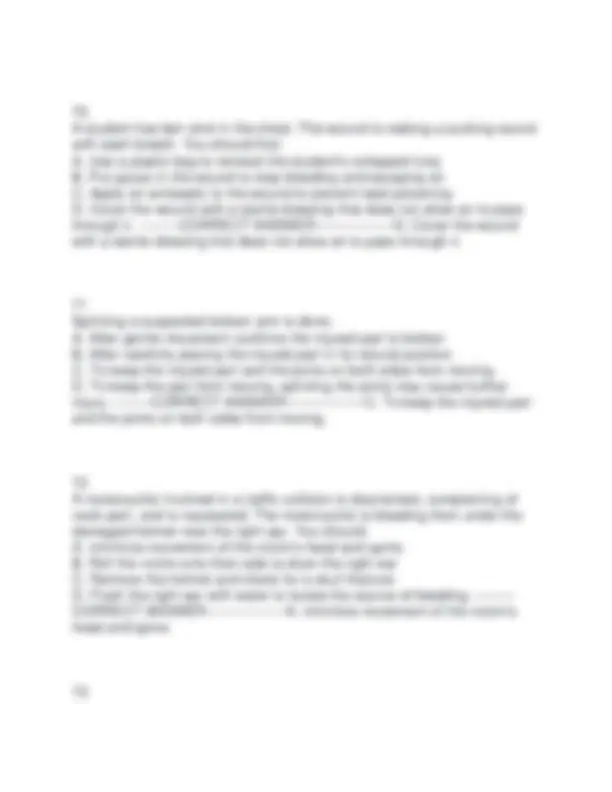
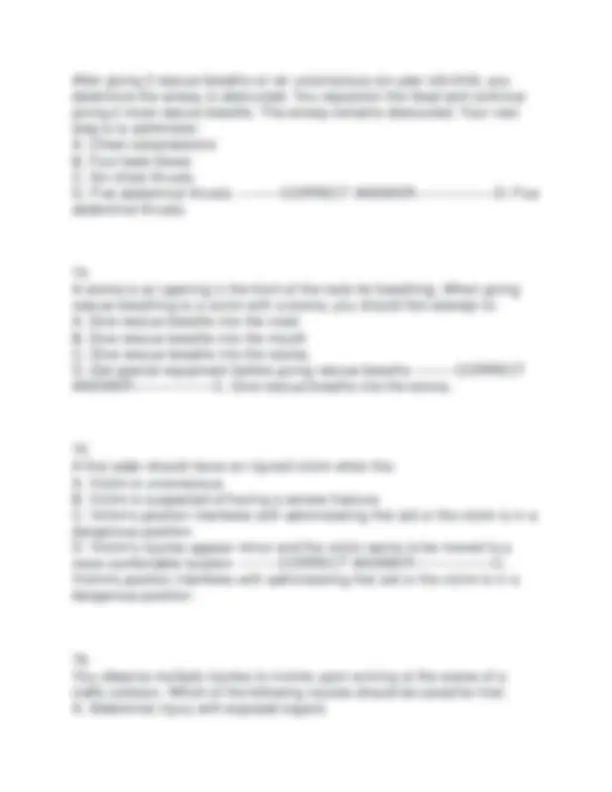
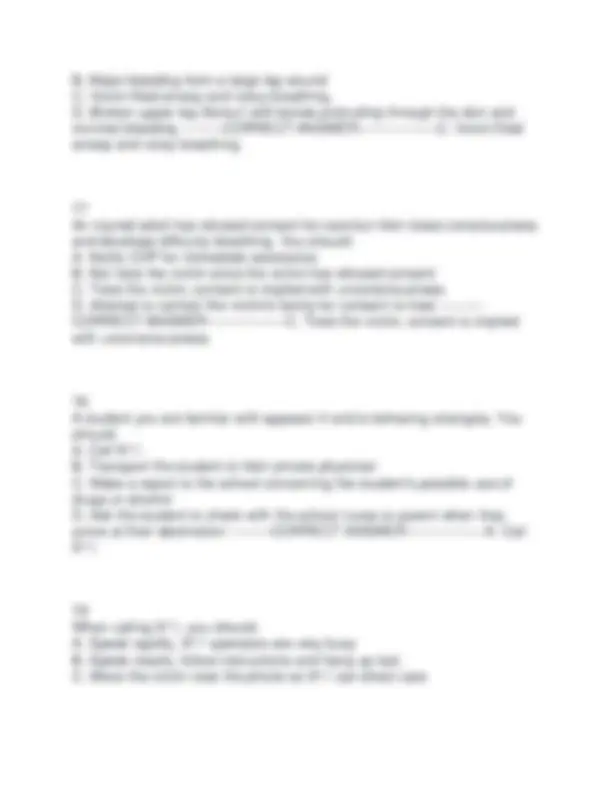
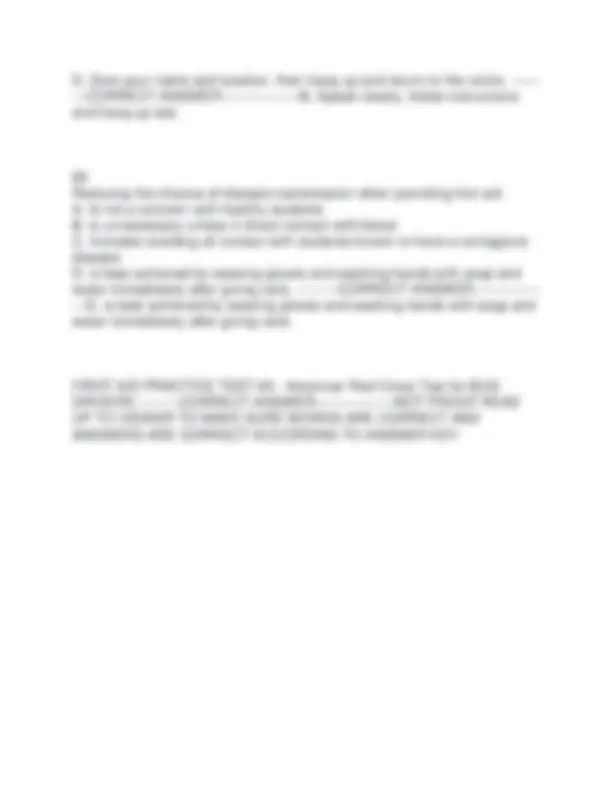


Study with the several resources on Docsity

Earn points by helping other students or get them with a premium plan


Prepare for your exams
Study with the several resources on Docsity

Earn points to download
Earn points by helping other students or get them with a premium plan
Community
Ask the community for help and clear up your study doubts
Discover the best universities in your country according to Docsity users
Free resources
Download our free guides on studying techniques, anxiety management strategies, and thesis advice from Docsity tutors
FIRST AID PRACTICE TESTS 1 2 AND 3 (AMERICAN RED CROSS TEST) | ALL QUESTIONS AND CORRECT ANSWERS | VERIFIED ANSWERS | LATEST VERSION
Typology: Exams
1 / 73

This page cannot be seen from the preview
Don't miss anything!


































































Although choking is common in infants and children, more _______ than _______ die each year as a result. A. children / adults B. adults / children ---------CORRECT ANSWER-----------------B. adults / children 2 One of the most dangerous threats to a seriously injured victim is unnecessary movement. A. true B. false ---------CORRECT ANSWER-----------------A. true 3 Which statement regarding impaled object is correct? A. in most cases the object should not be removed. B. A splinter may be removed with tweezer if it is in the skin. C. In all cases impaled objects should not be removed. D. Both a & b are correct. ---------CORRECT ANSWER-----------------C. In all cases impaled objects should not be removed. 4
If a victim is choking and yet still able to breathe or speak, the first aider should: A. Use abdominal thrusts. B. Encourage the victim to continue to cough forcefully on his/her own. ----- ----CORRECT ANSWER-----------------B. Encourage the victim to continue to cough forcefully on his/her own. 5 First aiders should not put themselves in grave danger. Dangerous situation should be left to: A. Only licensed Emergency Medical Technicians or Licensed Physicians or Nurses. B. Professionals like fire fighters and police who have the training and equipment to deal with them. ---------CORRECT ANSWER-----------------B. Professionals like fire fighters and police who have the training and equipment to deal with them. 6 To call the EMS system, you should use: A. 911 as it applies throughout the United States and you will get immediate help. B. The local emergency telephone number for your area and work place. --- ------CORRECT ANSWER-----------------B. The local emergency telephone number for your area and work place. 7 The most common type of wound is a ________. It can easily become infected if not keep clean. A. Avulsion B. Bruise C. Cut D. Scrape ---------CORRECT ANSWER-----------------D. Scrape
Before giving first aid to an injured or ill person, the first aider must have permission. The only exceptions are: A. if the conscious victim is a child and the condition is serious. B. If the victim is unconscious or unable to respond. C. Both a & b are correct. ---------CORRECT ANSWER-----------------C. Both a & b are correct.. 13 First aiders need to stay calm and think before they act. There are three basic steps to take: A. Check the scene, call 911, and care for the victim B. Evaluate the situation, call 911, and secure care for the victim. --------- CORRECT ANSWER-----------------A. Check the scene, call 911, and care for the victim . 14 When the first aider calls EMS there are important steps to follow. Which statement is most correct? A. Call 911 and give the exact location of the emergency. Then, do nothing until EMS arrives. B. Call the emergency number. Give the dispatcher the necessary information. Do NOT hang up until the dispatcher hangs up. Give care to the victim. ---------CORRECT ANSWER-----------------B. Call the emergency number. Give the dispatcher the necessary information. Do NOT hang up until the dispatcher hangs up. Give care to the victim. 15 The MOST important thing you can do as a first aider is to: A. realize what care to provide. B. provide care until professional medical help arrives. C. call your local emergency phone number. ---------CORRECT ANSWER-- ---------------C. call your local emergency phone number.
Which of the following situations would LEAST likely require a call to the EMS system: A. the victim is either bleeding severely, unconscious, has chest pain or has no pulse. B. the victim is either vomiting, has a severe headache, or has slurred speech. C. the victim has a known medical history of epilepsy or has had a seizure and is now sleepy. D. The victim either has chest pain, pain in the abdomen, or appears to have broken bones. ---------CORRECT ANSWER-----------------C. the victim has a known medical history of epilepsy or has had a seizure and is now sleepy. 17 To find out if the victim's heart is beating, check the pulse at the carotid artery, which is located: A. in the side of the neck B. in the crease between the trunk of the body and the leg, near the groin. - --------CORRECT ANSWER-----------------A. in the side of the neck 18 A person that is hyperventilating feels: A. that they can't get enough air B. afraid and anxious or seem confused C. dizzy or fingers and toes feel numb and tingly D. All of the above ---------CORRECT ANSWER-----------------D. All of the above 19 The purpose of dressings is to: A. soak up blood and help keep germs out.
Soon after a victim stops breathing, the heart will stop beating. Brain damage is likely within: A. 6 to 10 minutes B. Over 10 minutes C. 4 to 6 minutes ---------CORRECT ANSWER-----------------A. 6 to 10 minutes 25 The first aider would give about _______ breaths in one minute for a young child, and then recheck the pulse. A. 12 B. 20 ---------CORRECT ANSWER-----------------B. 20 26 It is important to recognize the early signals of infection. Mark one of the signals that indicates serious infection. A. develop a fever and feel ill. Red streaks may develop B. area around the would becomes swollen and red C. area may feel warm or throb with pain D. may discharge pus ---------CORRECT ANSWER-----------------A. develop a fever and feel ill. Red streaks may develop. 27 Difficulty in breathing can be the first signal of a more serious emergency, such as __________. A. a heart problem B. an anxiety attack ---------CORRECT ANSWER-----------------A. a heart problem
When you arrive on an emergency scene, you need to look: A. for anything that might make the scene unsafe for you and others B. for clues as to what caused the emergency. C. carefully for more than one victim. It's easy to overlook a small child D. All of the above are important. ---------CORRECT ANSWER----------------- D. All of the above are important. 29 If a person vomits, a first aider should: A. Turn the victim on his or her back to let the material flow down the throat. B. Roll the victim on his or her side and clear the mouth of any matter. ------ ---CORRECT ANSWER-----------------B. Roll the victim on his or her side and clear the mouth of any matter. 30 When doing mouth-to-mouth rescue breathing, to avoid getting air in a victim's stomach: A. Don't breathe too long. B. Don't breathe too hard. C. Open the airway far enough. D. All of the above. ---------CORRECT ANSWER-----------------D. All of the above. 31 A victim whose airway is completely blocked can be identified when: A. There is difficulty speaking and the face is inflamed. B. he/she can't speak, cough forcefully or breath. ---------CORRECT ANSWER-----------------B. he/she can't speak, cough forcefully or breath.
B. Herpes simplex III ---------CORRECT ANSWER-----------------A. Rabies 37 When a first aider gives rescue breathing he or she should begin by: A. Pinching the victim's nose shut and making a tight seal around the victim's mouth with your mouth. B. Tilting the head back and lifting the chin to open the airway. --------- CORRECT ANSWER-----------------B. Tilting the head back and lifting the chin to open the airway. 38 When a choking victim has received abdominal thrusts, follow up care is important because there may have been: A. Internal injuries. B. Severe irritation of the throat. ---------CORRECT ANSWER----------------- A. Internal injuries. 39 The first aider, upon reaching a victim, should check first to see: A. If the victim is severely bleeding. B. If the victim is breathing with trouble or in a strange way C. If the victim is conscious or unconscious ---------CORRECT ANSWER---- -------------C. If the victim is conscious or unconscious 40 For an infant with a blocked airway, you will give 5 back blows between the should blades. You should support the infant by: A. Positioning the infant face down on a hard surface if possible, like a table. B. Positioning the infant face down on your forearm so that the head is lower than the chest. ---------CORRECT ANSWER-----------------B.
Positioning the infant face down on your forearm so that the head is lower than the chest. 41 The greatest risk of infection from diseases is when you touch blood or other body fluids. You should: A. avoid contact with body fluids when possible. B. place barriers such as disposable gloves or a clean dry cloth between the victim's fluids and yourself. C. Both a & b. ---------CORRECT ANSWER-----------------C. Both a & b. 42 When the heart beats in an irregular way, it is called a ___________ A. heart attack B. cardiac arrest ---------CORRECT ANSWER-----------------A. heart attack (really called an heart arrhythmia) (heart attack is a sudden & sometimes fatal thrombosis (clot) to the heart muscle resulting in the death of part of a heart muscle) (cardia arrest is the sudden sometimes temporary cessation of function of the heart) 43 When giving rescue breathing to an infant, seal your mouth over the infant's mouth and nose. Breathe only enough to see the chest rise, about __________________. A. 2 seconds B. 1 second C. 1.5 or 1 1/2 seconds ---------CORRECT ANSWER-----------------C. 1.5 or 1 1/2 seconds 44
A. difficulty in a giving first aid on the scene. B. An immediate danger such as fire, flood or poisonous gas. --------- CORRECT ANSWER-----------------B. An immediate danger such as fire, flood or poisonous gas. 49 A pressure bandage should be applied snugly to help control bleeding. If blood soaks through the bandage, you should: A. apply more dressings, Do not remove blood soaked ones. B remove the blood soaked dressings. Apply new sterile ones. - -------- CORRECT ANSWER-----------------A. apply more dressings, Do not remove blood soaked ones. 50 Most people who die of a heart attack die within__________ A. 1 hour B. 2 hours C. 3 hours ---------CORRECT ANSWER-----------------B. 2 hours 51 To find out if the heart is beating, check the pulse of an adult or child: A. At the side of the neck. B. Inside the arm, between the should and the elbow. ---------CORRECT ANSWER-----------------A. At the side of the neck. 52 When a first aider suspects a heart attack, he or she should: A. Convince the victim to stop activity and rest. Reassure and comfort the victim B. Try to obtain information about the victim's condition. Assist with any prescribed medication.
C. Call the local emergency number for help and continue monitoring the victim's condition. D. All of the above are important steps for care. ---------CORRECT ANSWER-----------------D. All of the above are important steps for care. 53 The main signal of a cardiac arrest is: A. Absence of pulse. B. Severe chest pains. C. Difficulty breathing, with the skin pale or bluish. ---------CORRECT ANSWER-----------------A. Absence of pulse. 54 CPR is: A. a combination of chest compression and rescue breathing. B. Abdominal compression and rescue breathing. ---------CORRECT ANSWER-----------------A. a combination of chest compression and rescue breathing. 55 When should the first aider stop CPR? A. Another trained person takes over. B. EMS personnel arrive and take over. C. It's unsafe or you're exhausted and unable to continue. D. All of the above. ---------CORRECT ANSWER-----------------D. All of the above. 56 For a small child, the first aider should give _______ breaths about every _______ seconds. A. 1breath in 3 B. 1 breath in 4
It may be only a matter of _________ before a child or infant dies in a life threatening emergency. A. 2 minutes B. Seconds C. 4 minutes ---------CORRECT ANSWER-----------------B. Seconds 62 A wound is _______ when the skin's surface is broken, such as scrapes, cuts and punctures. A. Closed B. Open ---------CORRECT ANSWER-----------------B. Open 63 A first aider should check an unconscious person to see: A. If the victim is breathing B. If the victim has a pulse C. If the victim is bleeding severely D. All of the above. ---------CORRECT ANSWER----------------- 64 D. All of the above. 64 _____________ bleeding is usually slow, steady and dark red. A. Capillary B. Venous C. Arterial ---------CORRECT ANSWER-----------------B. Venous 65 When a child hyperventilates, they are often frightened and confused and breathing is shallow and rapid. They may say that: A. They feel dizzy B. Their fingers and toes feel numb or tingly
C. Both a & b are correct ---------CORRECT ANSWER-----------------C. Both a & b are correct 66 When giving breaths to children, each breath should last about
A. 1 second B. 1.5 second C. 2 seconds ---------CORRECT ANSWER-----------------B. 1.5 second 67 The first aider should then turn the infant over and give ______ chest thrusts, no deeper than ______ deep. Repeat. A. 5 / one inch B. 3 / one inch C. 4 / two inches ---------CORRECT ANSWER-----------------A. 5 / one inch 68 If you find a child unconscious and not breathing, give rescue breathing for about _______ before calling the local emergency number. A. 2 minutes B. 1 minute C. 5 minutes ---------CORRECT ANSWER-----------------B. 1 minute 69 Choking is a common breathing emergency. Some common causes of choking are: A. Swallowing large pieces of poorly chewed food. B. Eating while talking excitedly, laughing or eating to fast. C. Walking, playing, or running with food or objects in the mouth. D. All of the above ---------CORRECT ANSWER-----------------D. All of the above
A. 3 seconds B. 6 seconds C. 5 seconds ---------CORRECT ANSWER-----------------C. 5 seconds. 75 Any chest pain that is severe, lasts longer than _______ minutes, or persists even during rest requires immediate medical care. A. 6 B. 10 ---------CORRECT ANSWER-----------------B. 10 76 When a first aider smells an unusual odor, he or she should A. Try to remove any victims as soon as possible. B. Put his/her own safety first. Leave the area if there is a strong odor. ------ ---CORRECT ANSWER-----------------B. Put his/her own safety first. Leave the area if there is a strong odor. 77 When giving rescue breathing, if the first aider suspects a victim has a head, neck, or back injury, he/she should: A. Try not to move the victim's head and neck B. try to lift the chin without tilting the head C. Remember that the non-breathing victim's greatest need is for air D. All of the above are correct ---------CORRECT ANSWER-----------------D. All of the above are correct 78 When the heart stops beating entirely, it is called _________ A. Heart Attack B. Cardiac Arrest ---------CORRECT ANSWER-----------------B. Cardiac Arrest
A first aider may also check for victim's breathing by: A. Putting his/her head near the victim's mouth and nose B. Watching the chest to see if it rises and falls C. Both are true ---------CORRECT ANSWER-----------------C. Both are true 80 The "Good Samaritan Law," gives legal protection to people who provide first aid when: A. They have asked a conscious victim for permission before giving care. B. They act as any reasonable and prudent person would under the same conditions. C. Both a & b are correct ---------CORRECT ANSWER-----------------C. Both a & b are correct. 81 A wound is _________ when the damage is to the soft tissues under the skin surface. A. Closed B. Open ---------CORRECT ANSWER-----------------A. Closed 82 For chest compression to be most effective, the victim should be placed: A. Lying flat, on his or her back, on a level surface. B. Place the victim in the most comfortable, usually the back, with the head and chest slightly elevated. ---------CORRECT ANSWER-----------------A. Lying flat, on his or her back, on a level surface. 83